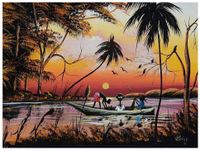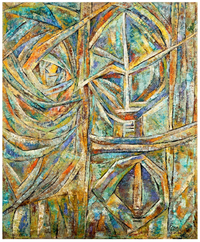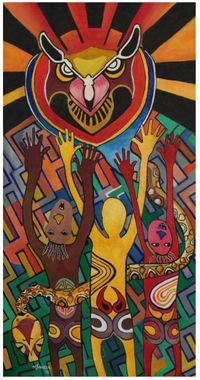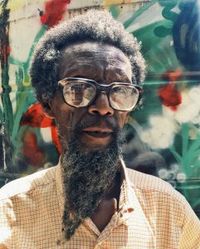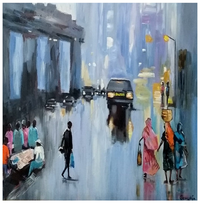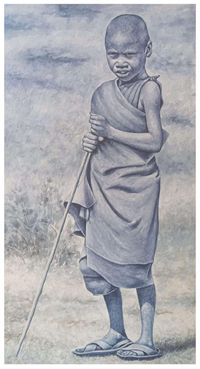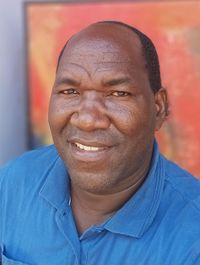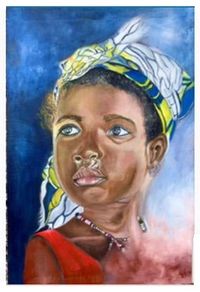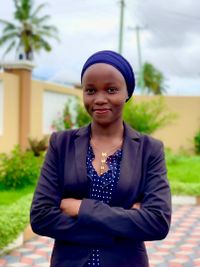Moderne tansanische Künstler:innen im Portrait
Im Folgenden stellen wir Ihnen die Künstler:innen vor, die sich an unserem Projekt beteiligen - vorerst ausschließlich Maler:innen und Fotograf:innen. Zum Verkauf stehende Werke von ihnen finden Sie in der Galerie, deren Bilder sich auf einen Klick entfalten. Scrollen Sie sich durch ihre Biografien, Werte und Ansprüche! Bei Interesse an einem besonderen Werk melden Sie sich dann später einfach bei uns.
Sarah Al-Baity - Suleiman Binda - Mikidadi Bush - Omary Chenga - Evarist Chikawe - Haji Chilonga - Fred Halla - Happy Robert - James Haule - Jamal Ali Mohamed - Shelina Khimji - Masoud Kibwana - Henry Kirenga - Krisper Kuchele - Lute Mwakisopile - Vita Malulu - Medy Maubaka - Jennifer Msekwa - Undare Mtaki - Lilian Munuo - Muzu Suleimanji - Aggrey Mwasha - Nimrod Hanai - Annah Lot Nkyalu - Ochu - Fadhil Raisy - Raza Mohamed - Mac Sawaya - Cuthbert Semgoja - Sigfried Hittu - Beatha Theonest - scroll down, please!
angekündigt/announced: Elias Jengo - Salum Kambi - Gadi Ramadhani - George Nyandiche
Portraits of contemporary Tanzanian artists
We introduce you to the artists who are participating in our project - initially only painters and photographers. You can find some of their works for sale in the gallery whose images unfold with one click. Scroll through the biographies, values and claims of Tanzanias visual artists! If you are interested in a particular work, simply contact us.
Sarah Al-Baity
Sarah Al-Baity wurde 1992 in Dar es Salaam geboren. Sie promovierte zur Zahnchirurgin an der Muhimbili University und ist zugelassene Zahnärztin in Dar es Salaam. Kunst war jedoch schon immer ihre Leidenschaft, insbesondere Fotografie und Acrylmalerei. Neben ihrem Beruf als Zahnmedizinerin lebt sie als autodidaktische abstrakte Künstlerin, die es liebt, neue Techniken in beiden Kunstgenres auszuprobieren.
2010 nahm Al-Baity zum ersten Mal an der Angaza Art Exhibition teil, die in Dar’s Mlimani City Mall stattfand. Anschließend stellte sie bei der 5. und 6. Ostafrikanischen Kunstbiennale aus (2011 und 2015), die in der Alliance Francaise, Nafasi Art Space stattfand, und 2015 auch an der Kunstausstellung der Universität von Dar in der Nkrumah Hall.
2017 bestritt Al-Baity ihre erste Duo-Ausstellung mit der Malerin Viviane Coupleux. Die Ausstellung nos-tal-gia präsentierte Fotografien und Malereien der beiden Künstlerinnen, die ein ähnliches Interesse für den sentimentalen Wert teilen, den Erinnerungen für Menschen haben. Sie fand in der Ausstellungshalle der Alliance Francaise statt.
„Die Inspiration für meine künstlerische Arbeit kommt nicht aus der Ferne. Es sind die alltäglichen Gegenstände und Aktivitäten in der Nähe, die mich faszinieren; einfache Dinge, die meine Aufmerksamkeit auf sich ziehen, die mich dazu bringen, sie zu erkunden - mich auf die kleinsten Details zu konzentrieren -, um die tiefsten Emotionen zu vermitteln."
Sarah Al-Baity was born in Dar es Salaam in 1992. She pursued a degree in doctor of dental surgery at the Muhimbili University of Health and Allied Sciences, and is a licenced dentist basd in Dar es Salaam. Art has, however, always been a passion for her, especially photography and acrylic paintings. Alongside her dental degree, she is a self-taught abstract artist who loves to explore new techniques in both art genres.
In 2010, Sarah first participated in the Angaza Art Exhibition held at Dar’s Mlimani City Mall. She has then participated in the 5th and 6th East Africa Art Biennales held at the Alliance Francaise, Nafasi Art Space (in 2011 and 2015 respectively), and again at the University of Dar es Salaam Art Exhibition in 2015, held in Nkrumah Hall.
In 2017, Sarah held her first duo-exhibition with co-artist Viviane Coupleux. The exhibition nos-tal-gia was a joint exhibition between the two artists who shared a similar love for the sentimental value that memories hold for humans. It was held in The Alliance Francaise exhibition hall.
"The inspiration for my art work doesn't come from afar.. It is the nearby ordinary objects and everyday activities that captivate me; simple things that catch my eye, that make me want to explore - to focus on the smallest of details -, and convey the deepest of emotions."
Klick zur Galerie/go to gallery
Suleiman Binda
Suleiman Rashid, bekannt als Binda (und nicht zu verwechseln mit seinem Sohn Yahya), wurde 1973 auf Pemba geboren, der neben Unguja zweiten Insel des halbautonomen tansanischen Teilstaats Zanzibar. Die Insel ist bekannt für ihre widerspenstigen Politiker und riesige Nelken-Plantagen, begründet auf ausufernder Sklavenarbeit.
Binda ist ein autodidaktischer Künstler, der viele Kurse und Workshops besucht hat. Er arbeitet hauptsächlich mit Acrylfarben und hat auch viele Wandgemälde gestaltet. Bindas Werke sind aufgrund ihrer ideologischen Bedeutung faszinierend, die sich am deutlichsten in seinem Stil manifestiert, den er Roundonismus nennt und dessen Markenzeichen Spiralen sind. Ein Stil, der sich auf die Bedeutung konzentriert, die dem Kreislauf des Lebens innewohnt.
1998 nahm er an der ersten Gruppenausstellung des Zanzibar International Film Festivals teil. Seitdem ist er dort regelmäßig zu sehen, später auch in Spanien und den Niederlanden. Binda war beteiligt an der letzten großen East African Art Biennale 2017/18 und hatte 2022 eine Soloausstellung im polnischen Stettin mit rund 20 Werken. Seit deren Gründung 2017 engagiert er sich auch für die CAGZ Art Gallery in Stonetowns Hafengebiet Malindi, die erste Galerie Sansibars, die ausschließlich von jungen Sansibaris geführt wird.
„Seine Bilder spiegeln die Energie wider, die wir in unserer Umgebung erfahren (Katalog ZIFF 2008). Besonders motiviert ihn die Idee, einen neuen Malstil zu erschaffen.
Ein 150 x 138 cm großes Werk von ihm wurde 2022 auf der Internetplattform onebid.pl für 850 € angeboten, die Warschauer Galerie Xanadu schätzte den Preis eines ähnlichen Werks auf 900 – 1000 €.
Suleiman Rashid, known as Binda, was born in 1973 on Pemba, the second island after Unguja in the semi-autonomous Tanzanian state of Zanzibar. The island is known for its unruly politicians and huge clove plantations, historically based on extensive slave labor. Binda is a self-taught artist who participated in many courses and trainings.
Binda creates works mainly with acrylics. He also has painted many murals. Binda’s works are intriguing due to their ideological meaning, which is most fully manifested in a style he calls Roundonism with spirals as ist hallmark. The style focuses on the meaning inherent in the cycle of life.
In 1998 and regularly thereafter, he took part in the group art exhibition at the Zanzibar International Film Festival (ZIFF). The festival started in 1998 and often shows local artists working in media other than film. He has participated workshops on pigment-making (2000), as well as on art theory and history (2002). Binda’s works have featured in group exhibitions at the Stone Town Cultural Centre and Serena Hotel) in Zanzibar. He was involved in the last major East African Art Biennale in 2017/18 and had a solo exhibition in Szczecin, Poland, in 2022 with around 20 works. His works have also been shown abroad in Spain and the Netherlands. Since its founding in 2017, he has also been involved with the CAGZ Art Gallery in Stonetown's Malindi waterfront, the first gallery in Zanzibar to be run exclusively by young Zanzibaris.
“His paintings reflect energy we experience in our environment”, according to the authors of the 2008 ZIFF catalogue. The artist’s motivation is to improve his art and create a new style of painting.
A 150 x 138 cm work by him was offered on the internet platform onebid.pl in 2022 for €850, the Warsaw gallery Xanadu estimated the price of a similar work at €900 – €1000.
Klick zur Galerie/go to gallery
Mikidadi Bush
Mikidadi Bush, geboren 1957 nahe des Lake Nyassa (Lake Malawi), Sohns des Tingatinga-Künstlers Bush Mikidadi Kikwetu (1934-2005), ist ein einzigartiger Fall in der zeitgenössischen afrikanischen Kunst.
Er ist einer der wenigen Tingatinga-Maler, die Malerei-Workshops am Goethe-Institut in Dar es Salaam belegten. Seine Karriere verlief nicht linear. Jahrelang verdingte er sich im Muhimbili Hospital und dann im Twiga Hotel. Später zog er nach Sambia, wo er sechs Jahre lang in einem Regierungsladen arbeitete. 1989 kehrte er nach Dar zurück und begann, in den Morogoro Stores im Tinga-Tinga-Stil zu malen. 1996 ging er auf Einladung von Kenji Bertheau-Suzuki für die Frida Gallery nach Tokyo. Später arbeitete er jahrelang in Italien mit dem Poeten Isaia Mabellini („Sarenco“, 1945-2017), wo er mehrere Ausstellungen hatte, u.a. auch gemeinsam mit George Lilanga. Sein täglich Brot verdient er sich bis heute mit kleinen Tingatinga-Werken, die er für den Touristenmarkt in den Morogoro Stores verkauft. Seine künstlerische Seele aber hängt an zeitkritischen Werken, die zuhause in Dar es Salaams Vorort Bunju entstehen.
Bush behandelt alte Themen, ewige Themen wie das Unbekannte, das Magische, den Untergrund, das Stammesleben, mit der gleichen Modernität wie die großen westlichen Künstler des 20. Jahrhunderts. Sein italienischer Förderer Sarenco nannte ihn in Anlehnung an Hieronymus Bosch „Hyeronimus Bush“. Mikidadi Bush sei „der wahre Schamane der zeitgenössischen tansanischen Malerei“. „Globalisierung und monotheistische Religionen haben versucht, die tausendjährige Geschichte und Kultur des Menschen auszulöschen, indem sie einen wirtschaftlichen und spirituellen Monomarkt schafften, der keine Abweichungen und keinen Wettbewerb zulässt.“ Dagegen stellt sich Bush mit seiner plastischen, zuweilen auch humorigen Malerei, die uns versöhnt mit den großen Themen des Lebens.
Heute ist "Bushi" (nicht zu verwechseln mit seinem Sohn Iddi Mikidadi, Jg. 1997), wie ihn seine Tingatinga-Kollegen in den Morogoro Stores nennen, der einzige zeitgenössische bildende Künstler Tansanias, der sich nicht nur mit den heimischen Mythen, sondern auch kritisch mit der kolonialen und vorkolonialen Vergangenheit des Landes auseinandersetzt.
Bush‘s Arbeiten werden international ausgestellt, seit 2024 z.B. auch im Hauptturm der Lotte-Hotels in Seoul, und zuweilen hoch gehandelt – zu Verkaufspreisen, von denen er nach eigenen Worten kaum je einen Shilling gesehen hat. Im Internet tauchen immer wieder auffällige Werke von ihm aus den Nuller- und Zehnerjahren auf, die er zwar mal (billig) verkauft hat, aber nie zum Weiterverkauf freigegeben hat. Damit dürfte er einer der ganz wenigen tansanischen Künstler sein, mit dessen Werken auf dem Kunstmarkt spekuliert wird.
Mikidadi Bush, born in 1957 near Lake Nyassa (Lake Malawi), is a unique case in contemporary African art.
He is one of the few Tingatinga painters who took painting workshops at the Goethe Institute in Dar es Salaam. His career was not linear. For years he worked at the Muhimbili Hospital and then at the Twiga Hotel. He later went to Zambia where he worked in a government store for six years. In 1989 he returned to Dar and started painting in the Morogoro Stores in the Tinga Tinga style. In 1996 he went to Japan at the invitation of Kenji Bertheau-Suzuki. He later worked for years in Italy with the poet Isaia Mabellini (“Sarenco”, 1945-2017). To this day, he earns his daily bread with small Tingatinga works that he sells to the tourist market in the Morogoro stores. But his artistic soul is attached to time-critical works that he creates at home in Dar es Salaam's suburb of Bunju.
Bush treats old themes, eternal themes such as the unknown, the magical, the underground, the tribal, with the same modernity as the great Western artists of the 20th century. His Italian sponsor Sarenco called him “Hyeronimus Bush” after Hieronymus Bosch.
Mikidadi Bush is “the true shaman of contemporary Tanzanian painting”. “Globalization and monotheistic religions have tried to erase thousands of years of human history and culture by creating an economic and spiritual mono-market that allows no deviations and no competition.” Bush stands against this with his plastic painting, which reconciles us with the great ones themes of life.
Today, "Bushi", as his Tingatinga colleagues call him in the Morogoro Stores, is the only contemporary artist in Tanzania who critically engages with the country's colonial and pre-colonial past.
Bush's works are sometimes sold at quite high prices internationally - at sales prices from which, in his own words, he has barely ever received a shilling. Eye-catching works of his from the noughties and 10s continue to appear on the Internet, which he once sold (cheaply) but never released for resale. This makes him one of the very few Tanzanian artists whose works are the subject of speculation on the art market.
Klick zur Galerie/go to gallery
Omari Chenga
Omari Ahmad Chenga kommt aus Ngupe, einem Dorf bei Masasi im Süden Tansanias. Seine Mutter war Künstlerin, alle in der Familie waren Kunsthandwerker. „Meine Großmutter webte Seile ebenso wie Matten, sie töpferte, um Haushaltsgegenstände herzustellen. Ich begann mich dafür zu interessieren und habe viel gelernt“, beschreibt Chenga seine Kindheit. „Für meine Töpferwaren bewunderten mich bald viele.“ Dieses Talent ist noch heute in seinen Gemälden zu erkennen.
Kunst wurde, obwohl sie in seiner Gemeinschaft keinen hohen Stellenwert hatte, zu Chengas Leidenschaft, dem einzigen, was ihm inneren Frieden gab. Durch die Hilfe einer Benediktiner-Schwester, die seine Begabung erkannte, kam er spät noch zu schulischer Grundbildun. Sie brachte ihn auch in Kontakt mit dem Künstler und Priester des Benediktiner-Klosters Ndanda Polykarp Uehlein, der schon Max Kamundi unterrichtete. Er brachte Chenga die Grundlagen des Zeichnens und Malens bei und vermittelte ihm auch einen Lehrer der Stein-Bildhauerei.
In seinen farbenfrohen Bildern, die inspiriert sind vom alltäglichen Straßenleben und viel Ähnlichkeit mit dem Werk des sechs Jahre älteren Kamundi aufweisen, webt er gern Körperteile, Augen, Münder und Ohren ineinander. „So will ich zeigen, dass es viele Menschen gibt, die zwar in unterschiedlichen Umgebungen leben, aber trotzdem alle auf derselben Welt.“
2002 zog Chenga nach Bagamoyo, um Kunstkurse an der TaSUBa zu besuchen. 2004 erhielt er den Ruf, an einem internationalen Kunstworkshop und einer Ausstellung im Senegal teilzunehmen. Ein Jahr später präsentierte Chenga eine Einzelausstellung in Deutschland und arbeitete mit einer Kunstgalerie in Broklyn/New York zusammen. Seitdem beteiligte er sich an vielen lokalen und internationalen Ausstellungen, zwischen 2012 und 2015 mehrmals erneut in Deutschland rund um Geesthacht. 2015 war Chenga zusammen mit Vita Malulu einer der Hauptteilnehmer der „Artist pro Wildlife“-Kampagne des Hamburger Sammlers und scharfen Tansania-Kritikers Peter-Andreas Kamphausen. 2024 war Chenga Artist in Residence im Heritage Centre in Arusha.
Chenga lebt und arbeitet als Kunstlehrer, Bildhauer und Maler in Bagamoyo, wo er das Talent’s Studio leitet. Seine Werke werden in Bagamoyo und im Heritage Center in Arusha verkauft, in Deutschland manchmal auch im Weltladen Würzburg.
Omari Ahmad Chenga was born in 1977 in Ngupe, a village located about 16 kilometer from Masasi. His mother was an artist, the whole family lived as handicraft artisans. “My grandmother weaved ropes as well as mats, she did pottery to produce pots. I became interested and went through that way too”, describes Chenga his childhood. “I was soon admired by everyone for my pottery.” This talent can still be seen in his paintings today.
Art, although not highly valued in his community, became Chenga's passion, the only thing that gave him inner peace. With the help of a Benedictine sister who recognized his talent, he received basic school education and came into contact with the artist and priest of the Benedictine monastery Ndanda Polykarp Uehlein, who had already taught Max Kamundi. “I was doing paintings for church murals even before I went to the art course.“ Uehlein taught Chenga the basics of drawing and painting and also brought Chenga into contact with stone sculpture.
In his colorful pictures, which are inspired by everyday street life and and have a lot of similarity to the work of Max Kamundi, who is six years older than him, Chenga likes to weave body parts, eyes, mouths and ears together. So “I want to show that there are many people who live in different environments, but still all in the same world”.
In 2002 Chenga moved from Ndanda to Bagamoyo for arts courses at the TaSUBa, then in 2004 he got a call to attend an international art workshop and exhibition in Senegal. A year later Chenga presented a solo exhibition in Germany, and worked with an art gallery in Broklyn New York. Later he attended more and more local and and international exhibitions, in Germany again in 2012, where he exhibited in Geesthacht and Scharnebeck.
In 2015 together with Malulu Vita he was one of the core participants of the “Artist pro Wildlife”-campaign of collector and sharp critic of Tanzanian corruption Peter-Andreas Kamphausen and his Hamburg Mawingu Collection. 2024 war er artist in residency am Heritage Center in Arusha. Chenga currently still lives and works as an art teacher, sculptor and painter in Bagamoyo, where he runs the Talent’s Studio.
Chengas works are sold in Bagamoyo and Arusha (Heritage Center), in Germany sometimes also at the One-World-Shop in Würzburg.
Klick zur Galerie/go to gallery
Evarist Chikawe
Evarist Fabian Chikawe kam 1974 in Dodoma zur Welt, genau in dem Jahr, in dem der Ort zu Tansanias Hauptstadt erklärt wurde. Er lebt und arbeitet in Dar es Salaam. Er gibt Workshops für Heranwachsende und engagiert sich als Netzwerker aktiv für die Künstlergemeinde. Chikawe war bereits in den 90ern Mitglied im Nyumba ya Sanaa (damals malte er noch im Stil ähnlich wie Max Kamundi) und ist seit 2017 Projekt-Koordinator der Vijana Vipaji Foundation, die Kunstförderung und eine Galerie im Dar es Salaamer Stadtteil Oysterbay betreibt.
Chikawe interessiert sich leidenschaftlich für kulturelle Hintergründe. Seine Arbeit bezieht sich häufig auf zyklische Aktivitäten wie in Erntezeiten und Geschichten aus dem Dorfleben, wie sie von den Ältesten erzählt werden.
„Meine Bilder identifizieren die Kultur und Tradition Tansanias. Ich beschäftige mich hauptsächlich mit figurativen Zeichnungen von Menschen, weil ich glaube, dass Menschen mein Leben prägen. Figuren machen es den Leuten leicht, meine Themen zu verstehen. Inspiriert bin ich von den farbenfrohen Menschen aus Tansania, die sich besonders in den Gewändern der Frauen widerspiegeln.
Kreativität schöpfe ich aus der tiefsten Seele meines Geistes. Im Leben dreht sich alles um Veränderung, Kunst wächst, Kunst kennt keine Grenzen. Ich mache Kunst für mich und teile sie mit der Öffentlichkeit, weil ich glaube, dass Kunst ein wirksames Medium ist, um Frieden zu lehren, Kultur zu bewahren, Menschen zu bilden und Gefühle auszudrücken.“
Heute zählt er zu den bekanntesten Künstlern Tansanias, der in der Zentrale der Bank of Tanzania ebenso dauerhaft ausgestellt wird wie im Präsidentenpalast. Seine erste Ausstellung hatte er mit 23 Jahren. Chikawe war artist in residence in Venedig und Kampala. Zuletzt präsentierte er seine Werke überwiegend in Gruppenausstellungen, 2022 z.B. in der Rangi Gallery in Dar, 2023 auf African Pop art Exhibition in Osaka genauso wie auf der Gulf-Tanzania International Art Show "Kiungo" in Dubai, zuletzt 2024 in der Dar es Salaamer Residenz des Schweizer Botschafters. Seit Jahren ist er immer wieder in verschiedenen europäischen Botschaften zu sehen, auch in der Kanadas und der USA sowie in der Alliance Française und dem Goethe Institut. Werke Chikawes waren 2019 bei der Stir it up!-Ausstellung der Elsa-Galerie in Bielefeld, zuvor auch in Braunschweig und München-Riemerling vertreten, wo die Ergebnisse aus einem Kurs bei Norbert Bisky an der Salzburger Sommerakademie präsentiert wurden. 2017 waren seine Arbeiten im vom BBK betriebenen Osnabrücker Kunst-Quartier zu sehen, 2023 im Bellevue in Bad Orb. Chikawes Werke konnte man auch schon in Nizza, Salzburg, Venedig, Washingtion DC, New Delhi, Venedig, Tampere, Kopenhagen, auf den Lofoten, in Irkutsk, Amsterdam, Kampala und Nairobi bewundern. 2024 war er beteiligt an der Gruppenausstellung "Different Art Different Audience" in Stone Town wie an der Ausstellung "ungana//connect" des sozialen Start Ups Asante Sanaa in Köln.
Versteigert werden seine Werke gelegentlich auf artauctioneastafrica.com der Circle Art Gallery aus Nairobi, wo schon 2013 A4-Holzschnitt-Drucke in Kleinstauflage für 900 $ aufgerufen wurden. Kleinere seiner Gemälde (60 x 40 cm) kosteten 2023 im Arusha Heritage Centre zwischen 300 und 600 $. Chikawes Werke werden auch vom Startup Asante Sanaa vertrieben, dessen frühe Preise aus unserer Sicht seine künstlerische Position nicht widerspiegelten (60 x 80 cm für 425 €/2023), die aber mittlerweile deutlich angezogen haben (50 x 40 cm für 600 €). Gleichwertige Arbeiten bietet die Rangi Gallery in Dar für 900 bis 1.100 $ an, größere liegen dort deutlich über 1.500 €.
Evarist Fabian Chikawe was born 1974 in Dodoma, in the same year, when this town became the capital of Tanzania. He works and lives in Dar es Salaam. Chikawe is an established artist and actively involved in the artist community, was a member of Nyumba ya Sanaa in the 90s (at that time he still painted in a style similar to Max Kamundi). Since 2017, he has been the project coordinator of the Vijana Vipaji Foundation, which run an arts fund and gallery in Dar es Salaam's Oysterbay district.
He is passionate about his cultural background and his work frequently depicts cyclical activities such as harvest times and stories of village life as related by the elders.
“My paintings identify the culture and tradition of Tanzania.
I mostly deal with figurative drawings of people because I believe that people shape my life. Characters make it easy for people to understand my themes. I am inspired by the colorful people from Tanzania, which are particularly reflected in the women's robes.
I draw my creativity from the deepest soul of my mind. Life is all about change, art grows, art knows no limits. I make art for myself and share it with the public because I believe art is an effective medium to teach peace, preserve culture, educate people and express feelings.“
Today he is one of the most well-known artists in Tanzania, who is exhibited in the headquarters of the Bank of Tanzania as well as in Mama Samias state house. He had his first exhibition at the age of 23. Most recently, he presented his works mainly in group exhibitions, e.g. in 2022 at the Rangi Gallery in Dar, in the "Different Art Different Audience" showcase in Stone Town, Zanzibar, and the "Ungana connect Art Exhibition" in Cologne, Germany.
His solo exhibitions, including retrospectives and showcases at prestigious institutions like the Goethe Institute in Dar es Salaam, reflect his ability to command attention with his unique style and thematic depth. From Talisman Restaurant in Nairobi to the UN Recreation Center, his solo exhibitions have left an indelible mark on audiences across East Africa.
For years he has been seen in various European embassies, also in those of Canada and the USA, as well as in the Alliance Francaise and the Goethe Institute. Works by Chikawe were represented at the 2019 Stir it up! exhibition at the Elsa Gallery in Bielefeld, previously also in Braunschweig and Munich-Riemerling, where the results of the participants of Norbert Bisky's workshop at Salzburg International Summer Academy were presented. In 2017 his works could also be seen in the Kunst-Quartier in Osnabrück operated by the BBK (German Association of Visual Artists). Chikawe's works have been admired in Nice, Salzburg, New Delhi, Venice, Tampere, Copenhagen, Lofoten, Irkutsk, Amsterdam, Kampala and Nairobi. Years ago, Chikawe was also an artist in residence in Venice and Kampala. In 2024 he participated with the German start-up Asante Sanaa at their "ungana//connect" exhibition in Cologne.
His works were sometimes offered at artauctioneastafrica.com of the Circle Art Gallery in Nairobi, where as early as 2013 A4-woodcut prints were called for $900. Smaller paintings (60 x 40 cm) cost between $300 and $600 at the Arusha Heritage Center in 2023. Chikawe's works are also occasionally distributed by Asante Sanaa, whose initial prices, in our view, did not reflect his artistic position (60 x 80 cm for €425 in 2023). Meanwhile they have increased their prices. The Rangi Gallery in Dar sells works of similar quality for between $900 and $1,100, with larger ones costing over €1,500.
Klick zur Galerie/go to gallery
Haji Chilonga
Haji Mussa Chilonga wurde 1969 in Mtwara nahe der Südgrenze Tansanias zu Mosambik in einer Familie von Schmieden und Töpfern geboren. Er lebt und arbeitet seit Jahrzehnten in Dar. Nachdem er erkannt hatte, dass Kunst anders als Sport ein lebenslang reifendes Handwerk ist, startete er Anfang der 1990er Jahre seine Karriere als Werbeschilder- und Porträtmaler. In frühen Zeiten bewunderte er den Tiermaler David Shepard. Darauf konzentrierte er sich anfangs ebenfalls. Doch er war ambitioniert genug, um sich damit nicht zufriedenzugeben. Er wollte seinen eigenen Stil finden, mit dem er sich identifizieren konnte. Daraus entstand seine abstrakte Arbeit mit Stillleben und abstrakten Kompositionen, die das tägliche Leben skizzieren.
„Chilongas ausdrucksstarker Stil kann als obskur beschrieben werden. Die Art und Weise, wie er seine Motive darstellt, reduziert seine Motive auf ihre grundlegendsten Formen. Dahinter steht der Versuch, das zu mystifizieren, was sonst weithin erkennbar ist.“ (Rangi Gallery) Sein unverwechselbarer Stil inspirierte auch den jüngeren und heute sehr erfolgreichen Maler Thobias Minzi. Auch für andere aufstrebende tansanische Künstler:innen wie z.B. Happy Robert wurde er zum Mentor.
Chilonga verstand die Bedeutung des kontinuierlichen Lernens und die Bedeutung stetiger Praxis. Seine künstlerische Ausbildung erfuhr er in Dar es Salaam und an der Internationalen Sommerakademie Salzburg (2007, 2014). Er ist ein kollaborativer Künstler, der an vielen internationalen Workshops teilgenommen hat und in den letzten Jahren auf fast zwanzig Einzelausstellungen zurückblickt, unter anderem in der Banana Hill Art Gallery in Nairobi und in Galerien in Dar und Arusha. Chilonga nahm auch an vielen Gruppenausstellungen in Tansania, Kenia, Uganda, Ruanda, Südafrika, Sambia, der Schweiz, Schweden, Großbritannien, Österreich, den Vereinigten Staaten, Kanada und Deutschland teil, seit 2022 z.B. regelmäßig beim Afrika-Festival in Tübingen, wo er 2025 den Titel eines "Afrikanischen Kulturbotschafters" erhielt. 2023 waren Werke von ihm auch in der GLS Bank Bochum ausgestellt. Den bisherigen Höhepunkt seiner Ausstellungskarriere stellte die Beteiligung an der 60. Kunstbiennale in Venedig dar, auf der er 2024 gemeinsam mit Happy Robert und Lutengano Mwakisopile (Lute) den ersten tansanischen Pavillon bestückte, den es jemals auf dieser weltweit ältesten und wichtigsten Ausstellung zeitgenössischer Kunst gab (vgl. "Topics").
Bekannt für die Bandbreite seiner Werke wurde er mehrfach ausgezeichnet. Einige seiner Werke sind seit 2004 dauerhaft im Präsidentenpalast ausgestellt.
So erfolgreich Chilonga auch ist, er hat immer noch Träume. Er hofft, dass seine Arbeit eines Tages über den afrikanischen Kontinent hinaus bekannt und in Büchern und Filmen zu sehen sein wird.
„Die Kunst zu nutzen, um mich selbst auszudrücken, macht mich glücklich; es ist wie Nahrung für meine Seele. Kunst ist Leben. Ohne Kunst gibt es kein Geheimnis, dass die Welt nicht so wäre, wie sie ist. Kunst ist in allen Lebensbereichen gefragt.“
Große Werke Chilongas werden heute recht hoch gehandelt. Die Rangi Gallery in Dar bot 2023 eines seiner Bilder (170 x 150 cm) für 4.000 $ an, kleinere Formate (110 x 110 / 80 x 80 cm) für 1.700 €. Ähnliche Preise rief die benachbarte Slipway Heritage Gallery auf, während im meist eher als Preistreiber fungierenden Arusha Heritage Centre der hohe Wert noch nicht ganz angekommen war. Das Bayreuther Social Startup Asante Sanaa markiert den unteren Preisrahmen. Dort ließ sich 2022 ein 80 x 60 cm großes Acrylbild von Chilonga, das in ähnlicher Qualität in Dar für 1.100 € gehandelt wurde, für 525 € erwerben, ein 75 x 74 cm großes für knapp 400 €. MIttlerweile haben die Preise deutlich angezogen. Ein 99 x 70 cm großes Werk kostet in Bayreuth 2024 850 €.
Haji Mussa Chilonga was born in 1969 in Mtwara close to Mozambique, into a family of blacksmiths and potters. Since decades he lives and works in Dar. After realising, that art instead of sports is a craft that matures with lifetime, with the beginning of the 1990th he started his career as a commercial signage and portrait painter. In early times Chilonga admired David Shepard, a wildlife painter so his journey started off focusing on wildlife painting. Ambitious as Chilonga was, he was not satisfied and wanted to find his own style that he could identify with. Eventually he found his signature in abstract work. Since he has moved on to still life and abstract compositions which show daily life. „Chilonga’s expressive style can be best described as obscure, due to the manner in which he depicts his subjects, that he thereby reduces his subjects into their most basic shapes in an attempt to mystify what is otherwise widely recognizable.“ (Rangi Gallery) His distinct style inspired the younger and today really successful painter Thobias Minzi. He also became a mentor for other up-and-coming Tanzanian artists such as Happy Robert.
Furthermore, he understood the importance of continuous learning and remembered the importance of practice. He underwent artistic training in Dar es Salaam and at the Salzburg International Summer Academy, Austria (2007, 2014). He is a collaborative artist who has participated in many international workshops and has a lot of solo exhibitions under his belt, among others at the Banana Hill Art Gallery in Nairobi and galleries in Dar and Arusha. Haji Chilonga participated also in many group exhibitions in Tanzania, Kenya, Uganda, Rwanda, South Africa, Zambia, Switzerland, Germany, Sweden, the United kingdom, Austria, the United States and Canada. The highlight of his exhibition career so far is his participation in the 60th Art Biennale in Venice, where he will equip the first Tanzanian pavilion together with Happy Robert and Lutengano Mwakisopile (Lute) in 2024. It was the first time that Tanzanian artists took part at this world's oldest and most important exhibition of contemporary art (see "Topics").
Known for the wide range of his works, he has received several awards. Some of his works have been permanently displayed at Tanzania State House since 2004. As successful as Chilonga is, he still has dreams. He hopes that someday his work would be prominent and popular beyond the African continent, featured in books and movies.
„Using art to fully express myself is what makes me happy; it is like food for my soul. Art is life. Without art, there is no secret that the world would not be as it is. Art is required in every aspect of life.“
Large works of Chilonga are traded quite highly today. In 2023, the Rangi Gallery in Dar offered one of his paintings (170 x 150 cm) for $4,000, smaller formats (110 x 110 / 80 x 80 cm) for €1,700. The neighboring Slipway Heritage Gallery called similar prices, while the high value had not quite arrived at the Arusha Heritage Centre, which usually acts as a price-raiser. The Bayreuth social start-up Asante Sanaa marked the lower price range. In 2022, an 80 x 60 cm acrylic painting by Chilonga, which was sold in Dar for €1,100 in a similar quality, could be purchased here for €525.
Klick zur Galerie/go to gallery
Fred Halla
Fred Gerald Halla, bekannt als fredhalla, wurde 1975 in Songea, einer pulsierenden Stadt im Süden Tansanias, geboren. Schon in jungen Jahren war er autodidaktischer Künstler. Seine Kreativität und die Leidenschaft für visuellen Ausdruck brachte ihn an die Uni. 2005 schloss er sein Studium der Bildenden und Darstellenden Kunst an der Universität Daressalam mit einem Bachelor ab.
Fred engagiert sich aktiv in der Kunsterziehung und unterrichtete bis 2020 an verschiedenen Privatschulen, wo er junge Talente förderte und Kreativität im Unterricht förderte. Seine Erfahrung im Bildungsbereich legte den Grundstein für eine umfassendere Vision – eine Vision, die Kunst als Instrument für gesellschaftliches Engagement, Selbstbehauptung und kulturelle Bereicherung nutzt.
Auf dieser Grundlage gründete Fred Urithi Arts, ein dynamisches Kunstzentrum mit Schwerpunkt auf öffentlicher Kunst, Künstlerausbildung und gemeindebasierte Projekte. In Zusammenarbeit mit dem Nafasi Art Space initiierte er mehrere Programme, darunter „The Make Up“ (2024), ein öffentliches Kunstprojekt, das den Magufuli Bus Terminal mit lebendigen Wandgemälden verschönerte. Darüber hinaus startete er Ausbildungsprogramme für aufstrebende Künstler und koordiniert Kunstresidenzen, wie beispielsweise die „Utulivu Art Residency“ 2025, die in Zusammenarbeit mit APAO Village-Kigamboni und der Emerson Zanzibar Foundation stattfand.
Derzeit leitet Fred über Urithi Arts das Cheche-Projekt, das Schweißern die Fähigkeit zur Metallbildhauerei vermittelt, ihre kreativen Fähigkeiten erweitert und nachhaltige Praktiken durch die Verwendung von Altmetall fördert.
Fred gilt mit seiner langjährigen Erfahrung als vielseitiger Künstler und engagierter Kulturschaffender. Seine Arbeiten umfassen Aquarelle, Acrylfarben, Ölgemälde, Druckgrafik und Collagen, wobei Aquarelle sein bevorzugtes Medium sind. Er lässt sich von der Natur und dem Alltag im ländlichen und städtischen Tansania inspirieren und beschäftigt sich häufig mit sozialen, wirtschaftlichen, politischen und kulturellen Themen.
Freds setzt sich leidenschaftlich für kulturellen Austausch ein und glaubt an die Kraft der Kunst, Wahrnehmungen herauszufordern, zum Dialog und Handeln anzuregen und Empathie zwischen Gemeinschaften aufzubauen. Seine Beiträge zur tansanischen Kunstlandschaft finden breite Anerkennung. 2008 wurde er vom British Council mit dem International Young Creative Entrepreneur Award for Visual Arts ausgezeichnet, der einen Austausch in Großbritannien beinhaltete. Freds fortlaufende Arbeit inspiriert und bestärkt viele andere Künstler.
Seit Ende des letzten Jahrtausends ist Halla auf Gruppenausstellungen vertreten, z.B. im russischen Kulturzentrum oder der finnischen Botschaft. Gezeigt wird er u.a. auch im Nationalmuseum. 2015 nahm er an der Kunstausstellung der Uni Dar teil. 2017/18 wurden Werke von ihm auf der East African Art Biennale ausgestellt. Fred Halle hat so manchen Preis gewonnen, z.B. beim Don Bosco Malwettbewerb, bei Wettbewerb des Bevölkerungsfonds der Vereinten Nationen und bei einem Jugendfestival in Uganda.
Fred Gerald Halla, widely known as fredhalla, was born in 1975 in Songea, a vibrant town in the southern part of Tanzania. A self-taught artist from an early age, Fred’s passion for creativity and visual expression led him to pursue formal education in the arts. He earned a Bachelor’s Degree in Fine and Performing Arts from the University of Dar es Salaam in 2005.
Fred has been actively involved in art education, teaching in various private schools from 2007 and again from 2014 to 2020, nurturing young talent and fostering creativity in the classroom. His experience in education laid the groundwork for a broader vision—one that uses art as a tool for community engagement, empowerment, and cultural enrichment.
Building on this foundation, Fred went on to establish Urithi Arts, a dynamic art centre focused on public art, artist training, and community-based projects. Under Urithi Arts in collaboration with Nafasi Art Space, he has initiated several impactful programs, including The Make Up (2024), a public art project that beautified the Magufuli Bus Terminal with vibrant murals. He has also launched training programs for emerging artists and coordinated art residencies, such as the Utulivu Art Residency in 2025, held in collaboration with APAO Village-Kigamboni and Emerson Zanzibar Foundation.
Currently, through Urithi Arts, Fred is spearheading the Cheche Project, which introduces metal sculpture skills to welders, expanding their creative capacities and promoting sustainable practices through the use of scrap metal.
With over 15 years of experience, Fred is recognized as a versatile artist and committed cultural practitioner. His work spans watercolors, acrylics, oils, printmaking, and collage, though watercolors remain his preferred medium. He draws inspiration from nature and daily life in both rural and urban Tanzania, often exploring themes related to social, economic, political, and cultural issues.
Fred’s artistic mission is deeply rooted in communication, dialogue, and social transformation. He is a passionate advocate for cultural exchange and believes in the power of art to challenge perceptions, inspire action, and build empathy across communities.
His contributions to Tanzania’s art landscape have been widely acknowledged. In 2008, he was awarded the International Young Creative Entrepreneur Award for Visual Arts by the British Council, which included an entrepreneurial exchange in the UK. Fred’s ongoing work continues to inspire and empower others. His paintings have been exhibited at the National Museum of Tanzania, and the Russian Cultural Center and the Finish Embassy in Dar es Salaam, among other places. In 2015 he participated in the University of Dar Art Exhibition at Nkrumah Hall. 2017/18 his works were exhibited at the East African Art Biennial. He has won prizes for his artwork in the Don Bosco drawing and painting competitions in 1995 and 1996 and in the UNFPA Painting Competition and the Youth Festival, Uganda.
Klick zur Galerie/go to gallery
Happy Robert
Happy Frank Robert, die in Dar es Salaam lebt und arbeitet, wurde 1989 in Songea im südlichen Teil Tansanias geboren. Interesse an Kunst zeigte sie schon früh, indem sie mit Perlen spielte und zeichnete. Sie sagt: „Kunst ist die Lösung und das Heilmittel, sie ist Therapie.“
Ihre Arbeit konzentriert sich darauf, die weibliche Form und deren Essenz einzufangen und Gefühle und ihren Stolz auszudrücken. Happy hat sich im Stillen einen Namen gemacht und ihre künstlerischen Fähigkeiten und Erfahrungen unter der Anleitung ihres tansanischen Künstlerkollegen Haji Chilonga weiterentwickelt. Ihre Fähigkeiten, Kenntnisse, Erfahrungen und künstlerische Inspiration erlernte sie auch im Kontakt mit anderen lokalen Künstlern wie Evarist Chikawe und Cuthbert Semgoja.
Sie hat an Workshops und Schulungen teilgenommen, die von Kunst- und Kulturinstitutionen in Dar es Salaam organisiert wurden. Sie ist stolz und glücklich, in diesem von Männern dominierten Bereich mit männlichen Künstlern zusammenzuarbeiten und in deren Ateliers eine Reihe von Werken zu produzieren. Heute wird sie nicht nur von der Rangi Gallery als „eine aufstrebende Künstlerin, die man im Auge behalten sollte“ eingestuft.
Bei den meisten ihrer Werke handelt es sich um Gemälde, in denen Frauen ihre Gefühle, Emotionen und ihren Stolz zum Ausdruck bringen. Wie die Rangi Gallery schrieb: „Die expressionistischen Porträts von Happy Roberts zeigen oft ganz normale Frauen und vermitteln ein tiefes Gefühl der Emotionalität, da sie oft in einem Zustand der Klage, Kontemplation oder Hochstimmung dargestellt werden, was sich in ihren Gesten und Haltungen ausdrückt. In ihren Arbeiten kommen oft leuchtende Farben und kräftige Pinselstriche vor, die die Gefühlsgeladenheit der Porträts steigern und gleichzeitig eine schmeichelhafte Darstellung des Motivs schaffen.“ 2020 nannte die Wochenzeitung „The East African“ ihren Stil einmal „eine Art lockeren Realismus oder verwässerten Impressionismus“, ihre Porträts seien „abwechselnd direkt, charmant und skurril“.
Happys Werke wurden bereits in Dar es Salaam, Sansibar, Arusha, Nairobi und auch in Europa sowohl in Gruppenausstellungen als auch in Einzelausstellungen gezeigt. Ein erster Höhepunkt ihrer Karriere war 2019 ihre erste Einzelausstellung in der Banana Hill Gallery in Nairobi, am gleichen Ort bestritt sie ein Jahr später zusammen mit Haji Chilonga und Abubakary Chikoyo eine viel beachtete Gruppenausstellung. Im gleichen Jahr wurde sie zur Teilnahme an der Affordable Art Show der Kenya Museum Society (der „größten Kunstausstellung in Ostafrika“) eingeladen, wo nur 10% aller angebotenen Werke von Frauen stammten. Darüber hinaus gehörte Happy 2019 zu den Moderatoren des von der Schweizer Botschaft gesponserten Projekts „My Trash My Treasure“, bei dem die Botschaft 80.000 $ an fünf lokale Organisationen und Gruppen auslobte, die sich zum Ziel gesetzt haben, das Umweltbewusstsein in verschiedenen Regionen Tansanias durch die Künste zu fördern. Die nächste hochrangige Gruppenausstellung folgte 2020 in der Residenz des belgischen Botschafters in Dar, wo sie zusammen mit Hedwiga Tairo, Jennifer Msekwa, Poni Yengi, Reena Davis und Jasmin Bakar und anderen im von der Rangi Gallery kuratierten „Women in Art – Showcase“ ausstellte. 2021 und auch 2022 arbeitete sie einige Wochen als Artist in Residence auf Gibb's Farm in der Ngorongoro Conservation Area. 2023 waren Werke von Happy Robert auf einer Ausstellung zugunsten des Nairobi-Nationalparks in Nairobi zu sehen, 2024 in der ostafrikanischen Gruppenausstellung "Side by Side" in Kigali/Ruanda. Den bisherigen Höhepunkt ihrer Ausstellungskarriere stellte Roberts Beteiligung an der 60. Kunstbiennale in Venedig dar, auf der sie 2024 gemeinsam mit Haji Chilonga und Lutengano Mwakisopile (Lute) den ersten tansanischen Pavillon bestückte, den es jemals auf dieser weltweit ältesten und wichtigsten Ausstellung zeitgenössischer Kunst gab (vgl. "Topics").
Zu den Sammlern ihrer Kunst zählen die Fairmont Hotels & Resorts, außerdem wird sie regelmäßig im Wild Flour Café in Dar's Oysterbay ausgestellt und verkauft. Das Social Startup Asante Sanaa bot 2023 ein älteres, heute für ihr Werk untypische Löwenportrait mit den Maßen 64 x 64 cm für 190 € an, ein anderes, noch etwas kleineres Portrait für 215 €. Aktuelle Kunstwerke von Happy Robert kosten je nach Größe und Motiv zwischen 300 und 2.500 Euro. Im Jahr 2023 verkaufte die Rangi Gallery ein 80 x 60 cm messendes Gemälde für 650 $, gleichzeitig wurde dort ein großes Werk (170 x 120 cm) für 2.700 $ angeboten. Die Photizo Art Gallery aus Nairobi verkaufte 2022 ein 95 x 120 cm großes Gemälde von ihr für 1.200 $, ein 55 x 65 cm großes Gemälde wurde für 300 $ angeboten.
Happy Frank Robert who lives and works in Dar es Salaam was born in 1989 in Songea, in the southern part of Tanzania. Her interest in art began early in her life by working with beads and creating drawings. She says: „Art is the solution and the remedy, it is therapy.”
Her work focuses on capturing the female form and essence, expressing their feelings and pride. Happy has quietly build up her name developing her art skills and experience under the mentorship of fellow Tanzanian artist Haji Mussa Chilonga. She nurtured her skills, knowledge, experience and art inspiration also from other local artists such as Evarist Chikawe or Cuthbert Semgoja.
She has attended workshops and training organized by art and cultural institutions in Dar es Salaam. She feels proud and happy to work in this male dominated field with male artists when producing body of works in their studios. Today she is classified not allone by Rangi Gallery as „an emerging artist hailed as one to watch“.
Most of her works are paintings largely focused on females expressing their feelings, emotions and pride. As Rangi Gallery wrote: „Often depicting ordinary women, Happy Roberts’s expressionistic portraits convey a deep sense of emotionality within her subjects as they are often shown in a state of lamentation, contemplation and elation, as expressed through their gestures/posture. Her work often employs the use of vibrant colors and bold gestural brush strokes that in effect heighten the emotionality of the portraits whilst also creating a flattering representation of the subject.“ In 2020 the "East African" called her style „a sort of loose realism, or a watered down impressionism“, her "portraits are by turns direct, charming and whimsical".
Happy’s works have been showcased in Dar es Salaam, Zanzibar, Arusha, Nairobi and also in Europe through both group exhibitions and solo exhibitions. One of her highlights was her first solo exhibition in 2019 at Banana Hill art gallery in Nairobi, the same venue where she exhibited one year later together with Haji Chilonga and Abubakary Chikoyo. Also in 2019 she was invited to participate at Kenya Museum Society’s Affordable Art Show (the ‘biggest art show in East Africa’), where only 10% of all works offered were created by female artists. Furthermore, in 2019 Happy was among the facilitators from the 14+ Artists group during the „My Trash My Treasure“ project sponsored by the Swiss embassy where the embassy donated 80.000 $ to five local organisations and groups aiming at encouraging environmental consciousness through the arts in various regions of Tanzania. The next high ranked group exhibition followed in 2020 at the residence of the Belgian Embassador in Tanzania, where she exhibited at the „Women in Art – Showcase“ curated by Rangi Gallery together with Hedwiga Tairo, Jennifer Msekwa, Poni Yengi, Reena Davis and Jasmin Bakar and others. In 2021, even in 2022 she worked for some weeks as artist in residence at Gibb's Farm (Ngorongoro Conservation Area). In 2023 she participated at an exhibition for the benefit of Nairobi National Park in Nairobi, 2024 at the East-African group show "Side by Side" at the Impundu Arts Center in Kigali/Rwanda. The highlight of her exhibition career so far was her participation in the 60th Art Biennale in Venice, where she equipped the first Tanzanian pavilion together with Haji Chilonga and Lutengano Mwakisopile (Lute) in 2024. It was the first time for Tanzanian artists to show their works at this world's oldest and most important exhibition of contemporary art (see "Topics").
Among the collectors of her art are the Fairmont Hotels & Resorts, she is also regularly exhibited and sold at the Wild Flour café in Dar's Oysterbay. In 2023, the social start-up Asante Sanaa offered an older lion portrait measuring 64 x 64 cm for €190. Current artworks by Happy Robert range between €300 and €2500, depending on the size and motives. In 2023 Rangi Gallery sold a 80 x 60 cm painting for $650, at the same time it offered a big one (170 x 120 cm) for $2700. The Photizo Art Gallery from Nairobi in 2022 sold a 95 x 120 cm painting $1.200, a 55 x 65 cm big one was offered for $300.
Klick zur Galerie/go to gallery
James Haule
James Haule wurde in einem kleinen Dorf in der Küstenregion Bagamoyo geboren. Von der Kindheit an bis zur weiterführenden Schule hat er viel gezeichnet. Nach der Schule verdingte er sich viele Jahre lang als Schildermaler, bevor er 2006 dem Wasanii Art Center beitrat.
Seitdem hat er an mehreren lokalen Workshops sowie nationalen und internationalen Ausstellungen teilgenommen. 2006 wurden Werke von ihm z.B. im Nationalmuseum gezeigt, 2008 auf der indischen Küstenkunstausstellung auf den Malediven und 2013 im Hyatt in Dar. Er nahm zweimal an der Ostafrikanischen Biennale teil, das letzte Mal 2017/18, als die Kunstschau in ganz Ostafrika, in Dar, Arusha, Nairobi, Kampala, Kigali und Bujumbura ausstellte.
Haule, der überwiegend mit Acrylfarben arbeitet, ist Realist. Er malt impressionistisch, gleichwohl sind seine Motive stets genau erfasst. Er ist ein feinfühliger Chronist tansanischer Kulturen und Naturschauspiele. Mit verwischten Hintergründen fängt er Stimmungen ein, gleichzeitig schärfen sie den Fokus aufs Wesentliche.
James Haule was born in a small village in the coastal region of Bagamoyo. From childhood to high school, he drew a lot. After school he worked as a sign painter for many years before joining the Wasanii Art Center in 2006.
Since then he has participated in several local workshops as well as national and international exhibitions. In 2006, his works were shown at the National Museum, in 2008 at the Indian Coastal Art Exhibition in the Maldives and in 2013 at the Hyatt in Dar. He has participated in the East African Biennale twice, the last time in 2017/18, when the art show exhibited across East Africa, in Dar, Arusha, Nairobi, Kampala, Kigali and Bujumbura.
Haule, who works primarily with acrylic paints, is a realist. He paints impressionistically, but his motifs are always captured precisely. He is a sensitive chronicler of Tanzanian cultures and natural spectacles. He captures moods with blurred backgrounds, while at the same time sharpening the focus on the essentials.
Klick zur Galerie/go to gallery
Jamal Ali Mohamed
Jamal Ali Mohammed wurde 1983 in Sansibar geboren und wuchs dort auf. Sein künstlerisches Talent begann sich seit seiner Kindheit zu entwickeln. 2002 schrieb er sich am Kunstinstitut Sansibars ein, um eine grundlegende Kunstausbildung zu absolvieren, die er ein Jahr später abschloss. Danach belegte er nochmals einen vom Aga Khan Cultural Trust gesponserten Kurzkurs für Bildende Kunst unter einem Dozenten der Universität of Arkansas (USA). Seitdem hat er weitere Workshops besucht, um seine künstlerischen Fähigkeiten und Qualifikationen zu verbessern.
Jamal ist ein zeitgenössischer Maler, der verschiedene Medien und Kunstformen verwendet, darunter Wasserfarbe und Acryl. Seine Kunstwerke sind in verschiedenen Sammlungen und Unternehmen überall auf den Inseln Sansibars zu finden. Die farbenfrohen Kunstwerke verführen den Betrachter in eine spielerische Atmosphäre der Erkundung und Fantasie. Jamal ist ein kreativer bildender Künstler, der nicht nur die Kunst liebt, sondern Menschen inspirieren und aufklären möchte. Er ist gern in der Öffentlichkeit, um Menschen in Not zu unterstützen, marginalisierte Gruppen wie Menschen mit Behinderungen und Waisen. Seine Kunst spiegelt auch sein Interesse an Reisen und der Kultur wider. Er träumt davon, ein berühmter internationaler Künstler zu werden, der rund um den Globus reist und Ausbildungszentren für Künstler betreibt.
Jamal hat seine Kunstwerke in zahlreichen Ausstellungen innerhalb und außerhalb Sansibars präsentiert, darunter auf der East Africa Art Biennale (2017) in Dar es Salaam, Arusha, Nairobi, Kigali und Bujumbura, auf der Zanzibar Tourism Show im Verde Hotel 2019, bei Emerson‘s Zanzibar Exhibitions (2. Platz 2021), auf Zanzibar‘s Cultural Festival wie auf dem International Film Festival (ZIFF).
Jamal Ali Mohammed was born and raised in Zanzibar in 1983. His artistic skills started to develop since his childhood. He enrolled at the Nyumba ya sanaa (Institute of Art) in Zanzibar to undertake basic fine Art education in 2002 where he graduated in 2003. Yet, he attended in an abridged course for Visual Art sponsored by Aga Khan Cultural services under an instructor from the University
of Arkansas (USA) held in Zanzibar in 2002. Since then, he has participated in various workshops to improve his artistic skills and qualification.
Jamal is a contemporary painter using different mediums and art forms which include water colour and acrylic. His artworks are found in various collections and businesses throughout Zanzibar. His colourful artworks keep the viewer in a playful atmosphere of exploration and imagination. Jamal is a creative visual artist who not only loves to inspire individuals and the public through his art but also he loves to educate others and support the people in need including those marginalised groups such as people with disability and orphans His art also reflects his interest in travel and culture. He dreams of becoming a famous international visual artist, who travels across the globe and operates centres for artists’ education and practice.
Jamal has showcased his artworks in many exhibitions conducted in and outside Zanzibar which include East Africa Art Biennale (2017), Zanzibar Tourism show (Verde Hotel 2019), Emerson Zanzibar Exhibitions (2nd runner up 2021), Zanzibar Cultural Festival, Zanzibar International Film Festival (ZIFF).
Klick zur Galerie/go to gallery
Shelina Khimji
Shelina Khimji (* 1973) ist eine preisgekrönte Künstlerin aus Tansania, die sich seit ihrer Kindheit zur Kunst hingezogen fühlt. Sie lebt und arbeitet in Dar es Salaam und Dubai. In Zanzibar erzogen, prägten afrikanische genauso wie arabische Einflüsse ihre Kindheit. Sie hat auch in Großbritannien, den USA und den Vereinigten Arabischen Emiraten gelebt. Diese Mischung sticht in ihrer Arbeit mit Farben und Schichten hervor, die ihre multikulturelle Identität widerspiegeln. Neben ihrer Tätigkeit als Künstlerin ist sie seit 2004 staatlich zugelassene Wirtschaftsprüferin und verfügt über langjährige Erfahrung als Revisorin und Managerin bei Grant Thornton und Crowe Tanzania.
Farben verleiht sie eine besondere Symbolik, sie sollen ihre glückliche Persönlichkeit und den Blick auf eine ideale Welt betonen. Khimji hat ein natürliches Talent fürs Zeichnen. Ihr Stil ist impressionistisch, sie möchte mit ihren Kunstwerken Emotionen erzeugen und die Vorstellungskraft der Betrachterin bzw. des Betrachters erweitern.
Ihre Sujets zeigen oft Kulturen mit einem zeitgenössischen Touch. „Ich liebe es, den alten und antiken Look darzustellen und mit meinen Kunstwerken Nostalgie und romantische Gefühle hervorzurufen. Ich versuche meine Fantasien einzufangen, eine Erinnerung, einen Gedanken, eine Sehnsucht, den Blick auf die Welt durch die rosarote Brille, und gleichzeitig benachteiligte Menschen zu berücksichtigen, bedrohlich enge Gassen und starke, feminine Frauen.“ Sie macht Skizzen, malt Abstraktes, Porträts oder figurative Kunst und Kalligrafie. Meist verwendet sie dafür Bleistifte, Kohle, Öl und Acryl, gern auch verschiedene Materialien gleichzeitig. In letzter Zeit hat sie Werke mit Kaffeefarbe gemalt, Acryl- und Aquarellsprenkel hinzugefügt und schließlich mit Kaffeetassenflecken, Blumen, Blättern und Pinselstrichen abgeschlossen.
Mit dem Pinsel taucht sie in ihre Seele und beschwört ihre Fantasien. „Die imaginären Orte und Träume, die ich auf die Leinwand werfe, ermöglichen es mir, mich zu verlieren und meine inneren Sehnsüchte zu erfüllen, indem ich sie in einem Gemälde lebendig werden lässt. Wir sind alle Kunstwerke und das Universum ist eine göttliche Leinwand."
Khimjis Stärke liegt in dem zeitgenössischen Gefühl, das sie der tansanischen Kunst gegeben hat, sowie in der Art und Weise, wie sie ihre Kunst für ihre Werte sprechen lässt, wenn es um den Erhalt der Umwelt oder die Anerkennung der weniger Privilegierten geht.
Über ihre langjährige Karriere hinweg wurde sie auf CNNs Online-Plattform “Style“ für ihre Lockdown-Kunstwerke vorgestellt, die an ein in Dubai ansässiges Kunststudio eingereicht wurden. Sie hat als einzige tansanische Künstlerin auf der World Art Dubai 2020 ausgestellt. Sie wurde ausgewählt, Tansania in der von der ZeeArts Gallery organisierten Ausstellung zum Frauentag unter 115 Frauen aus verschiedenen Ländern zu vertreten. Ihre Arbeiten wurden auch im Art & Lusso Magazine (Online-Magazin für Kunst, Mode und Luxus-Lifestyle in den Vereinigten Arabischen Emiraten und Italien) vorgestellt, im Magazin Modern Renaissance des US Culturally Arts Collective, im Addition Art Magazine des US Divide Magazine sowie in der tansanischen Tageszeiting „Citizen“, die über Khimjis Teilnahme an der Ausstellung „Colors Of Hope“ der örtlichen Rotaracts (Rotary-Junioren) berichtete.
2023 wurde Shelina Khimji in der Holy Art Gallery in London und in Athen (www.theholyart.com) ausgestellt, zuvor auch in Dubai in der Artoze und der dortigen Picasso Gallery und im Mövenpick Hotel Bur Dubai für ein Live-Painting-Event von CAWFEE arts eingespannt. 2024 war sie Tansanias erste Vertreterin auf der World Art Dubai Show, im Frühjahr 2025 war vertrat sie ihr Land auf der Internationalen Kunstausstellung "Art Connects Women" der Dubaier zeearts_gallery. Sie wurde von der Rangi Gallery in Dar ausgewählt, um Werke im Rahmen von deren Kampagne unter dem Titel „Ode an die Frau“ auszustellen. Vor Jahren (2016/17) stellte sie auch mit anderen im Russischen Kulturzentrum in Dar aus. Sie war Teilnehmerin an vier der letzten fünf Ausgaben der East African Art Biennale, Werke von ihr wurden kürzlich auch auf der Queen Elizabeth II gezeigt. 2021 hatte sie eine Einzelausstellung im „Drum“ in Dar es Salaam mit dem Thema „Sameness within Diversity“ (Gleichheit in Vielfalt).
Khimji war zweimal Finalistin beim New York and os Angeles Coffee Art Project. Sie trat kürzlich der „Caffeine and Women Movement Community“ in Dubai bei als weibliche Pionierin für kreative Kaffeekunst. Sie ist Mentorin und Preisträgerin in ihrer lokalen Gemeinde und 2015 tourte ihr Skizzenbuch im Rahmen von The Sketchbook Project durch die USA und Kanada. 2013 gewann Shelina Khimji den einen Preis für ihre Bleistiftskizze „Lessons from Kerbala“ über eine Schlacht in der Geschichte der islamischen Kriege.
Khimjis Arbeiten wurden bereits von mehr als einem Dutzend Sammler:innen gekauft. Ihr Kunstwerk mit dem Titel „Coffee bloom“ wurde ausgewählt, um als NFT geprägt und im Dubai International Financial Centre in einem Konzept namens „Galerie in einer Box“ ausgestellt zu werden.
Ihr preisgekröntes Werk „Weaving a Legacy“ aus dem Jahr 2025 – eine runde Collage im Durchmesser von 40 cm mit Acrylfarben auf Karton – wird aktuell auf singulart.com für
2890 € angeboten.
Ein 6-Min-Selbstportrait der Künstlerin findet sich auf Youtube.
Shelina Khimji, born in 1973, is an award winning Tanzanian artist, drawn to art since her childhood. She lives and works in Dar es Salaam and Dubai. She has a rich African and Arabian background since she grew up in Tanzania and inherited the Zanzibari upbringing from her parents. She has also lived in Britain, USA and UAE. This combination tends to stand out in her work with the colors and layers highlighting her identity. Beside working as an artist she is a registered chartered accountant since 2004 and has long experience as an auditor and manager with Grant Thornton and Crowe Tanzania.
Color is her strong symbolism as it reflects her happy personality and images of an ideal world. She has a natural knack for drawing and her style is impressionistic since she loves giving an inkling to evoke her viewers emotions and imagination to her artworks.
“I love to depict the old and the ancient look and evoking nostalgia and romantic feelings in my artworks. I try to capture my fantasies, a memory, a thought, a longing, the glimpse of the world through rose tinted glasses, underprivileged people, typical narrow streets and strong, feminine women.” Her subjects often portray cultures with a contemporary feel. She makes sketches, paints impressionistic, abstract, portraits or figurative art and calligraphy. She mainly uses graphite, charcoal, oil and acrylic as well as mixed media. Most recently she has painted some works with coffee paint, adding acrylic and watercolor sparkles and finally finishing with coffee cup stains, flowers, leaves and brush strokes.
She believes art has allowed her to dip her brush into her soul and paint away her fantasies. The imaginary places and dreams that she expresses on the canvas permit her to lose herself and fulfil her inner longings by bringing them alive in a painting. "We are all works of art and the universe is a divine canvas."
Khimji’s strength lies in the contemporary feel she has given to Tanzanian art as well as how she lets her art speak for the values she holds when it comes to the preserving the environment and recognising the less privileged.
Over a decade long career, she has been featured on CNN’s online platform style for her lockdown artwork submitted to a Dubai based Art Studio. She has exhibited in World Art Dubai 2020 as the only Tanzanian artist. She was selected to represent Tanzania in the women’s day exhibition organized by ZeeArts Gallery among 115 women from different countries across the globe on the theme “rise to rejoice”.
Her work was featured in Art & Lusso Magazine (Online Magazine on Art, Fashion and Luxury Lifestyle in UAE and Italy), in the magazine Modern Renaissance of the US Culturally Arts Collective, in the Addition Art Magazine of US Divide Magazine, as well as in The Citizen (Tanzania) for participating in the Rotaracts, Colors Of Hope Exhibition.
Shelina Khimji has exhibited in the Saatchi and Holy Art Galleries in London and 2023 in Athens (www.theholyart.com), at the Dubai Artoze und Picasso Gallery, at Mövenpick Hotel Bur Dubai for a live painting event by CAWFEE arts. In 2024 she was the first Tanzanian who represented the country at the World Art Dubai show, and in spring 2025 she represented her country at the International Art Exhibition "Art Connects Women" at the Dubai zeearts_gallery. She was selected by Rangi Gallery in Dar to exhibit her work as part of their “Ode to Women” campaign. Years ago (2016/17) she also exhibited with others at the Russian Cultural Center in Dar es Salaam. She has been a participant in four of the last five editions of the East African Art Biennale, her works have recently been exhibited on the Queen Elizabeth II too. In 2021 she has had a solo exhibition at the Drum in Dar es Salaam with the theme “Sameness within Diversity.”
Khimji has been a two time finalist in the NY and LA Coffee Art Project. She recently joined the Caffeine and Women Movement community in Dubai as a female pioneer for being a coffee art creative. She is a mentor and award winner in her local community, and 2015 her sketchbook has toured USA and Canada as part of The Sketchbook Project. In 2013 Shelina Khimji scooped the winners award for a pencil sketch on a battle held in the history of Islamic wars, titled Lessons from Kerbala.
Khimji’s work has already found more than a dozen solvent collectors. Her artwork titled “Coffee bloom” was selected to be minted as an NFT and exhibited at the Dubai International Financial Centre nights in a concept called “gallery in a box.” Her award winning work "Weaving a Legacy" of 2025 - a round collage of 40 cm diameter with acrylic paints on cardboard - is currently offered on singulart.com for €2890.
A 6 minutes portrait of the artist you can find on Youtube.
Klick zur Galerie/go to gallery
Masoud Kibwana
Masoud Kibwana, der 1988 in Mtwara zur Welt kam, lebt seit er 15 ist in Dar es Salaam. Eine Ausbildung am Dar Youth Art Vocational Training Center (DYA) machte ihm bewusst, dass Künstler ein einträglicher Beruf sein kann.
Seine Werke thematisieren Politik, Gleichberechtigung und gesellschaftlichen Wandel. Dabei verwendet er eine innovative Flickentechnik mit Stoffen, um Struktur und Tiefe zu erzeugen. Gleichzeitig fördert er Nachhaltigkeit durch die Verwendung von Abfallmaterialien. Kibwanas Kunst hinterfragt Stereotype, regt den Dialog an und lädt zum Nachdenken über aktuelle gesellschaftliche Themen ein. Kibwanas Gemälde fangen auf der Leinwand die Schönheit, Kultur und Traditionen der ostafrikanischen Bevölkerung ein.
Er hat seinen eigenen Stil in einer nahtlosen Mischung zwischen Kubismus und figurativer Malerei vor abstrakten Hintergründen entwickelt. Mit akribischer Liebe zum Detail verleiht er den Themen in seiner Arbeit Leben und Tiefe. Eingebettet in seine Kunst sind die komplizierten Stammesmuster, die noch immer in die Gesichter der Makonde in Tansania und Mosambik tätowiert sind.
Seine Arbeit ist gekennzeichnet durch Bewegung, Verflechtung von Motiven und Farbkombinationen, deren Ursprünge nicht sofort zu identifizieren sind. Die detaillierten 3D-Applikationen, meist in Weiß, verleihen seinen Gemälden einen interessanten Aspekt.
Als Mixed-Media-Künstler ist Innovation sein ständiger Begleiter. Er experiementiert gern mit verschiedenen Stilen, z.B. indem er Jeansreste in seine Werke einbaut. Die Verwendung von Abfallmaterialien war auch der Schlüssel zur Schaffung von einzigartigen Installationskunstwerken. Kibwana hofft, dass seine Arbeit den Dialog über die Herausforderungen befördert, die Entwicklung und Nachhaltigkeit in der tansanischen Gemeinschaft behindern.
Die Rangi Gallery kommentiert: „Seine Motive bestehen oft aus menschlichen und tierischen Figuren, die wie Origami präsentiert werden. Er betont so ein Gefühl von Dreidimensionalität und Tiefe innerhalb der Anatomie und Perspektive des Motivs, wodurch es sich plastisch aus der Leinwand entfernt. Das ergibt eine Reihe herausragender Kunstwerke, die jeden Raum beleben.“
Kibwana war zuletzt "artist in residence" des Kuona Trusts in Nairobi, der Teil des globalen Triangle Network ist. Er hat seine Arbeiten sowohl lokal als auch international ausgestellt und wurde regelmäßig zur Teilnahme an der East African Art Biennale eingeladen. Er hat seine Arbeiten in Tansania, Kenia, Ruanda, Burundi, Uganda, Taiwan, China, Italien und 2022 auch im schleswig-holsteinischen Barmstedt gezeigt. 2023 lief eine Gruppenausstellung in der Umoja Art Gallery in Kampala. Arbeiten Kibwanas befinden sich auch in der Sammlung des Schlesischen Museums in Opava (Tschechischen Republik). 2024 schmückte er als Hauptkünstler der 127. Ausgabe den Titel und sechs Innenseiten des Universal Colours Magazine, des Magazins für professionelle migrantische Künstler. Er hat ein Arbeitsstudio im Nafasi Art Space in Dar es Salaam.
Auf der Internetseite des australischen awarethesocialdesignproject.com.au wurde ein älteres 75 x 96 cm großes „tribal art“-Werk Kibwanas 2023 für gut 500 € angeboten. In Dares Salaam wird er von der Rangi Gallery vertreten und dort hoch gehandelt. Ein thematisch besonders starkes, auf die Pandemie bezogenes 122 x 94 cm großes mixed-media Gemälde stand dort 2023 für 2.800 $ zum Verkauf. Im Nafasi Art Space in Dar rief er 2022 für ein 100 x 130 cm großes, besonders ausdrucksstarkes s/w-Werk 1.200 $ auf. Auf einer Ausstellung in Deutschland verkaufte er kürzlich zwei 120 x 120 cm große Mixedmedia-Werke für jeweils gut 4.000 €.
Masoud Kibwana, born in 1988 in Mtwara, is based in Dar es Salaam. His distinctive work blends cubism, figurative expression, and abstract backgrounds with intricate tribal patterns inspired by the Makonde people of Tanzania and Mozambique. Using his innovative kiraka (patchwork) technique with denim and other fabrics, Kibwana creates textured, three dimensional surfaces that captivate the viewer and spark conversation.
Since beginning his career after training at the Dar Youth Art Vocational Training Center, Kibwana has exhibited widely in key art markets including Germany, Italy, China, USA, and several African countries. His works have been featured in prestigious exhibitions such as the East African Art Biennale and in museums including The Silesian Museum in the Czech Republic.
Kibwana’s art addresses themes of politics, equality, and societal transformation while promoting sustainability through the creative reuse of materials. The Rangi Gallery comments: "His subjects often consist of human and animal figures presented in an origami-like manner. He thus emphasizes a sense of three-dimensionality and depth within the anatomy and perspective of the subject, causing it to sculpturally emerge from the canvas. This results in a series of outstanding works of art that will enliven any space."
His dynamic compositions marked by movement, vibrant yet unconventional color palettes, and striking 3D applications challenge stereotypes and invite deep reflection. Notable recent achievements include a residency at Kuona Trust in Nairobi (part of the global Triangle Network) and strong international sales. In 2024, he was the cover artist for the 127th issue of Universal Colours Magazine, dedicated to professional migrant artists.
His works are held in private collections worldwide as well as prominent institutional collections. Based at Nafasi Art Space in Dar es Salaam, Kibwana continues to develop innovative techniques that merge traditional African artistry with a modern visual language, positioning his work as both culturally significant and globally relevant
On the website of the Australian awarethesocialdesignproject.com.au, an older 75 x 96 cm "tribal art" work by Kibwana was offered for a good 500 € in 2023. In Dar Kibwana is represented and traded highly by the Rangi Gallery. A thematically particularly strong, 122 x 94 cm mixed-media painting related to the pandemic was for sale there in 2023 for $2,800, smaller works (40 x 50 cm) were available from $350. At Nafasi Art Space in Dar, where Kibwana operates, a similar work cost $160 in 2022, while a 100 x 130 cm expressive b/w work was called for $1,200 there. At an exhibition in Germany he recently sold two 120 x 120 cm mixed media works for a good €4,000 each.
Klick zur Galerie/go to gallery
Henry Kirenga
Henry Wilhelm Kirenga wurde 2001 in Daressalam geboren. Nach der Schule erwarb er 2022 ein Zertifikat als Buchhaltungstechniker. Er ist bekannt für seine emotionsgeladenen und strukturierten Acrylgemälde. Mit Spachteln kreiert er kraftvolle Erzählungen, die afrikanische Identität, persönlichen Ausdruck und kulturelle Symbolik widerspiegeln. Seine Arbeiten greifen oft tansanisches Erbe auf und behandeln Themen wie Freiheit, Stärke und modernen afrikanischen Futurismus.
Kirenga hat mit großen Organisationen wie Vodacom, Airtel und Tigo sowie den gefeierten tansanischen Musikern Diamond Platnumz und Jux zusammengearbeitet und mit dem Nias Nyalada Art Studio am Mbezi Beach in Daressalam, in dem er Mitglied ist, immersive Kunstevents durchgeführt, die Musik und visuelles Geschichtenerzählen verbinden.
Seine Gemälde haben ein Publikum weit über Tansania hinaus erreicht, er hat Sammler in Deutschland, Japan und verschiedenen Teilen Ostafrikas. 2024 erhielt Kirenga eine Anerkennungsurkunde von Tumaini La Maisha (TLM) für seine Teilnahme an der Online-Kunstauktion „Bid for Life“ 2024 zur Unterstützung krebskranker Kinder in Tansania.
2025 will Henry 150 Kunstwerke vollenden und damit die Grenzen seines sich entwickelnden Stils und seiner Erzählkunst ausloten. Mit seiner Kreativität möchte er sich als aufstrebende Kraft in der afrikanischen Gegenwartskunst etablieren.
Wie bei Künstlern am Anfang der Karriere üblich, hat auch Kirenga seine Werke früh im Netz angeboten. Das Studio des befreundeten Künstlers Nias Nyalada in Dar's Vorort Mbezi Beach bot noch 2025 auf der eigenen Website einige frühe, 100 x 70 cm große Werke von Kirenga für weniger als 100 € an. Das wird sich nicht lange halten lassen.
Henry Kirenga is a contemporary visual artist born in 2001 in Dar es Salaam. After school, in 2022 he acquired a Certificate of Completion in Accounting Technician (ATEC).
Known for his emotionally rich and textured acrylic paintings, he uses palette knives to create powerful narratives that reflect African identity, personal expression, and cultural symbolism. His work often draws from Tanzanian heritage while exploring themes like freedom, strength, and modern African futurism.
Kirenga has collaborated with major organizations including Vodacom, Airtel, and Tigo, as well as celebrated Tanzanian musicians Diamond Platnumz and Jux - working alongside Nias Nyalada Art Studio at Mbezi Beach in Dar during immersive art sessions that bridge music and visual storytelling.
His paintings have reached audiences far beyond Tanzania, with collectors in Germany, Japan, and various parts of East Africa. In recognition of his contributions, Kirenga received a Certificate of Appreciation from Tumaini La Maisha (TLM) for his participation in the 2024 "Bid for Life" online art auction, supporting children with cancer in Tanzania.
In 2025, Henry set a personal goal to complete 150 artworks, pushing the boundaries of his evolving style and storytelling. Through his crativity he tries to establish himself as a rising force in African contemporary art.
As it is common with artists at the beginning of their careers, Kirenga also offered his works online early on. The Nias Nyalada art studio of a befriended artist in the Dar suburb of Mbezi Beach, was offering some of Kirenga's early, 100 x 70 cm works on its website for less than €100 as recently as 2025. This won't last long.
Klick zur Galerie/go to gallery
Krisper Kuchele
Krisper Kuchele Mmole (Künstlername Kuchele) wurde 1967 in Masasi geboren. Er begann früh zu malen. Nach dem Abschluss der Schule 1982 besuchte er verschiedene Mal- und Töpferkurse. Er verwendet gerne Öl- und Acrylfarben mit Pinsel und Messer. Auch als Bildhauer, der vor allem Tierfiguren modelliert, betätigt er sich.
Kuchele ist bekannt für seine Dorfbilder, die auf realistische Weise Szenen und Aufgaben aus dem Alltag der verschiedenen tansanischen ethnischen Gemeinschaften zeigen. Auffallend als Künstler aber machen ihn vor allem seine Landschaftsbilder. Landschaftmalerei ist in der tansanischen Kunstszene selten.
Einige seiner Bilder schmücken auf Betreiben der britischen Investoren hin die alte Boma in Mikindani bei Mtwara, die als Hotelfachschule dient und dem Künstler so zu einiger Reichweite verhilft. Auch Ausstellungen finden dort statt. Im Dorf betreibt Kuchele auch eine eigene kleine Galerie. Um weitere Absatzmärkte zu erschließen und „Werbung zu machen“, verlegte er seinen Lebensmittelpunkt 2024 von Masasi nach Arusha, „vorübergehend“, wie der Künstler betont.
Kuchele hat dank der Kontakte übers Kloster Ndanda und Polykarp Uehlein und über das britische Boma-Projekt in Mikindani gute Verbindungen in die Gemeinde der Expats in Dar es Salaam und wird dort seit Jahrzehnten immer mal wieder gefördert. 2018 stellte er in der Vijana Vipaji Galerie im Dar es Salaamer Reichenviertel Oysterbay aus, im Laufe der Jahre auch mehrmals in Mtwara und zweimal in Finnland, zuletzt 2024.
Krisper Chechele Mmolele (artist name Kuchele) was born in Masasi in 1967. He began painting at an early age. After graduating from school in 1982, he attended various painting and pottery courses. He enjoys using oil and acrylic paints with brush and knife. He is also a sculptor, primarily modeling animal figures.
Kuchele is known for his village paintings, which realistically depict scenes and tasks from the everyday lives of Tanzania's various ethnic communities. However, his landscape paintings are what make him particularly notable as an artist. Landscape painting is rare in the Tanzanian art scene.
At the instigation of British investors, some of his paintings adorn the old boma in Mikindani near Mtwara, which serves as a hotel management school, thus giving the artist some exposure. Exhibitions are also held there. Kuchele also has run his own small gallery in the village. In order to develop further sales markets and "promote publicity," he relocated from Masasi to Arusha in 2024, "temporarily," as the artist emphasizes.
Thanks to contacts at the Ndanda Monastery and Polykarp Uehlein, as well as through the British Boma Project in Mikindani, Kuchele has connections to the expat community in Dar es Salaam and has received occasional support there for decades. In 2018 he exhibited at the Vijana Vipaji Gallery in Dar's Oysterbay, over the years several times in Mtwara too and twice in Finland, most recently in 2024.
Klick zur Galerie/go to gallery
Lute Mwakisopile
„Lute“ - Lutengano Mwakisopile - wurde 1973 in Dar es Salaam geboren. Er versteht sich selbst als bildender Künstler und Textildesigner. Zeichnen und Malen lernte er durch die Teilnahme an Workshops, jahrelang im Nyumba ya Sanaa und später bei Ausstellungen und Residenzen im In- und Ausland. Er drückt seine Ideen mit allem aus, was zur Verfügung steht: von recycelten Materialien über Pinsel, Bleistift, Kohle, Farben auf Leinwand, Papier oder auch als Holzschnitt. Trotz mancher Anlehnungen an Erzählweisen der Tingatinga-Designer distanziert er sich gezielt von dessen Schule.
Seine Kreativität kennt keine Grenzen. Die Themen entstehen aus Erinnerungen, Erfahrungen, Hoffnungen und Sehnsüchten. Abgeleitet aus dem Alltag, Lebensstilen und Ereignissen erzeugt Lute figurative Bilder und soziale Karikaturen, die politische Botschaften enthalten (s. auch den Beitrag unter "Topics" aus dem Juni 2025) . So regt er die öffentliche Diskussion an und schafft Dekoratives mit Bezug zum Publikum. „Kunst ist eine Idee, die ich habe, und ich finde die kreativste Art, sie auszudrücken.“
Er begann seine Karriere als Künstler und Textildesigner im Jahr 1992, als er sich dem inzwischen aufgelösten Nyumba ya Sanaa in Dar anschloss und dort mehr als zehn Jahre arbeitete. Raza Mohamed, der damals viele Schulbücher illustrierte, faszinierte ihn, hier auch entdeckte er den holländischen Künstler M.C. Escher als Vorbild. Seither lebt Lute überwiegend von Druckgrafiken. Später wurde er Studiomitglied des Nafasi Arts Center (2008-2018). Lutes Arbeiten wurden außer in Ostafrika auch schon in Dänemark, den USA, Italien, Kanada und Norwegen gezeigt. Den bisherigen Höhepunkt seiner unzähligen Ausstellungen bildetet 2024 die Beteiligung als einer von drei tansanischen Künstler:innen an Tansanias erstem jemals auf Venedigs Biennale gezeigten Kunstpavillon.
Lute ist Gründer der Wasanii Visual Arts Company und Mitglied der Tanzania Federation of Crafts & Arts (TAFCA). Er ist außerdem Vorsitzender der Fine Artists Association of Tanzania und der losen Künstlergruppe 14+. Darüber hinaus hat er im Auftrag zahlreicher Unternehmen, NGOs, Ministerien, Verbände und Buchverlage gearbeitet.
Der Künstler hat verschiedene Auszeichnungen bei verschiedenen Kunstwettbewerben erhalten, unter anderem als erster Gewinner des Oscars of African Creativity 2019 in Kairo/Ägypten.
Lute - Lutengano Mwakisopile - was born in 1976 in Dar es Salaam. The visual artist and textile designer is self-taught. He learned to draw and paint by taking part in workshops and later at exhibitions and residencies at home and abroad. He expresses his ideas with everything that is available: from recycled materials to brushes, pencils, charcoal, paints on canvas, paper or even as a woodcut. Despite some references to the narrative styles of the Tingatinga designers, he deliberately distances himself from this school.
His creativity knows no limits. The themes arise from memories, experiences, hopes and longings. Derived from everyday life, lifestyles and events, Lute creates figurative images and social caricatures that contain political messages (see also the article under "Topics" from June 2025). In this way he stimulates public discussion and creates decorative items that relate to the audience. “Art is an idea I have and I find the most creative way to express it.”
He began his career as an artist and textile designer in 1992 when he joined the now defunct Nyumba ya Sanaa in Dar and worked there for more than ten years. He was fascinated by Raza Mohamed, who illustrated many school books at the time, and it was here that he discovered the Dutch artist M.C. Escher as a role model. Since then, Lute has made a living primarily from prints. He later became a studio member of Nafasi Arts Center (2008-2018). In addition to East Africa, Lute's work has also been shown in Denmark, the USA, Italy, Canada and Norway. A highlight of his countless exhibitions was his participation in 2024 as one of three Tanzanian artists in Tanzania's first art pavilion ever shown at the Venice Biennale.
Lute is the founder of Wasanii Visual Arts Company and a member of the Tanzania Federation of Crafts & Arts (TAFCA). He is chairman of the Fine Artists Association of Tanzania and the loose artist group 14+. He has also worked on behalf of numerous companies, NGOs, ministries, associations and book publishers.
The artist has received various awards in various art competitions, including being the first winner of the Oscars of African Creativity 2019 in Cairo, Egypt.
Klick zur Galerie/go to gallery
Vita Malulu
Vita Lulengo Malulu wurde in 1976 in Mwanza, Tansania, geboren. Er arbeitet in vielen Disziplinen, neben dem Malen bildhauert er, gestaltet Grafiken, tanzt und musiziert. Seine Ausbildung erhielt er am Bagamoyo College of Arts, wo er von 2003 bis 2006 studierte. Für seine Gemälde verwendet Malulu Öl und Acryl auf Leinwand. Große und kleine Installationen und Skulpturen entstehen aus recyceltem Material, gern aus Draht. Malulu hinterfragt in seinen Arbeiten die Herausforderungen und Schwierigkeiten, mit denen Menschen aus der Unterschicht konfrontiert sind, die oft sprachlos sind. Er porträtiert auch Szenen mit sozialen und politischen Kommentaren zu aktuellen Themen innerhalb und außerhalb Tansanias. Malulu malt sowohl realistisch als auch abstrakt. Seine Motive findet er auf Fotos und Alltags-Szenen auf der Straße. Als Musiker spielt Malulu mit der Gruppe „Tupo Kama Hatupo“ (frei übersetzt „Gibt es uns wirklich?“).
Malulu hat an mehreren internationalen Residenzen und Workshops teilgenommen, z.B. bei Konstepidemin im schwedischen Göteborg (2016), am NKD Norwegen (2013), in Tansania, Kenia und beim Uganda Arts Trust (2014). Er war auch mal beim Norsesund Art Walk in Schweden dabei.
Malulus stets detailversessenen Werke wurden in verschiedenen Einzel- und Gruppenausstellungen im In- und Ausland präsentiert. Neben Dar es Salaam, wo er häufig im Goethe-Institut, im Nafasi Art Space und bei der Alliance Francaise zu sehen war, konnte man Werke von ihm schon in der Rose Bank Mall in Johannesburg sehen, im Stenasalen des Göteborger Konstmuseums oder in Peter-Andreas Kamphausens Hamburger Mawingu-Sammlung, auch beim Ugandan Arts Trust in Kampalas 32 Grad Ost-Galerie, in Nairobi beim Kuona Trust und in der Circle Art Gallery, in Sansibar im Emerson Hotel.
Seinen Durchbruch in der heimischen Szene erlebte er nach seiner ersten Einladung zur East African Art Biennale 2013, an der auch später mehrfach beteiligt war. Er prägte mehrere Gruppenausstellungen durch seine parteiergreifende Kunst. 2015 bestückte er beispielsweise zusammen mit Gadi Ramadhani, Cloud Chatanda und Amani Abeid die Ausstellung „Beauty Salons and the Beast“, kuratiert von Rehema Chachage und Jan van Esch, die ein Gewinner im US-gesponserten apexart Franchise-Programm war. Das Projekt nutzte einen Wohnwagen im öffentlichen Raum und einen Schönheitssalon zur Präsentation von Kunst. Im selben Jahr beteiligte er sich als Bildhauer an der Gruppenausstellung „Kuriositätenkabinett“ im Nafasi Art Space. Auch bei einer wandernden Gruppenausstellung mit befreundeten Künstler:innen über Märkte und Dörfer bis nach Rwanda hinein war Malulu dabei.
Bekannt im Ausland machte ihn sein 2014 auf einem Workshop des Goethe-Instituts für das Hamburger Projekt “Artists pro Wildlife” entstandene Gemälde “Red Carpet”, das die Hamburger als “wahrscheinlich wichtigstes Bild, das in den letzten Jahren in Tansania gemalt wurde” feierten. Es wird bis heute öffentlich gezeigt. Angesichts des überaus scharfen Angriffs auf gleich zwei amtierende Staatsoberhäupter hätte man mit einem Verbot und der Verfolgung des Malers rechnen können. Selbst in Deutschland wäre er trotz Kunstfreiheit davor nicht gefeit.
Während Malulus Residenz in Kampala produzierte der Uganda Arts Trust 2014 einen kleinen Imagefilm für ihn; angesichts seiner Bedeutung als einer der streitbarster Künstler Tansanias produzierte sogar die Deutsche Welle 2018 eine Werkschau über ihn für ihren Kiswahili-Kanal.
Malulus teilweise wandfüllende Arbeiten werden in mehreren Galerien in Tansania, Südafrika und Deutschland gesammelt. Derzeit arbeitet er in einem Atelier im Nafasi Art Space in Daressalam, wo er auch Mitglied ist. Er ist außerdem Mitglied der Künstlergruppe 14+.
Vita Lulengo Malulu was born in 1976 in Mwanza, Tanzania. He is a multi-disciplinary artist working in the media of painting, sculpture, printmaking, music and dance. He received his training from the Bagamoyo College of Arts, where he studied from 2003 to 2006. For his paintings Malulu uses use oil and acrylic on canvas. For the creation of installations and sculptures in both small and large scale works he utilizes recycled materials like wire. Malulu creates work that interrogates challenges and difficulties that face the lower class majority of Tanzanians who are often rendered voiceless. He also portrays scenes concerning social and political commentary on current matters inside and outside of the borders of Tanzania. Malulu paints both realistic and abstract. His subjects come from photos and everyday scenes from the streets. The musician Malulu plays with the group “Tupo Kama Hatupo” (Present As Absent).
Malulu has participated in several international residencies and workshops with Konstepidemin/Gothenburg Sweden (2016), at NKD Norway (2013), in Tanzania, Kenya and with the Uganda Arts Trust (2014). He has also participated in the Norsesund Art Walk in Sweden.
Malulu’s always detailed works have been exhibited in various solo and group exhibitions locally and internationally. Beside Dar es Salaam, where he has been on dispose frequently at the Goethe Institute, at Nafasi Art Space and the Alliance Francaise, he has been visible even in Johannesburg’s Rose Bank Mall, in Stenasalen of Gothenburg’s Konstmuseum, or in the Hamburg Mawingu Collection of Peter-Andreas Kamphausen, also in with Ugandan Arts Trust in Kampala’s 32 degree East, in Nairobi with the Kuona Trust and at the Circle Art Gallery, in Zanzibar at the Emerson Hotel.
His breakthrough in the local scene came after his first invitation to the East African Art Biennale in 2013, in which he later took part several times. He shaped several group exhibitions with his partisan art.
In 2015 for example together with Gadi Ramadhani, Cloud Chatanda and Amani Abeid he hold the exhibition “Beauty Salons and the Beast”, curated by Rehema Chachage and Jan van Esch, which was a winner with the US-sponsored apexart Franchise Program. It used a caravan at public spaces for the presentation of art. In the same year he participated as a sculptor with the group exhibition “Cabinet of Curiosities” at Nafasi Art Space. Malulu also took part in a traveling group exhibition with artist friends through markets and villages all the way to Rwanda.
He became known abroad for his painting “Red Carpet”, created in 2014 at a Goethe Institute workshop for the Hamburg project “Artists pro Wildlife”, which the Germans celebrated as “probably the most important picture that has been painted in Tanzania in recent years”. It is still shown publicly to this day. In view of the extremely sharp attack on two current heads of state, one could have expected a ban and persecution of the painter. Even in Germany, despite artistic freedom, he would not be immune from this.
During his residency in Kampala, the Uganda Arts Trust produced a small image film of the artist in 2014; given his importance as one of Tanzania's most controversial artists Deutsche Welle produced a showcase for its Kiswahili channel in 2018.
Malulu’s works, some of which fill walls, are collected through several galleries in Tanzania, South Africa and Germany. He currently has a working studio space at Nafasi Art Space, Dar es Salaam, of whom he is a member too. He is also a member of the 14+ artist group.
Klick zur Galerie/go to gallery
Medy Maubaka
Ahmed Medy Mohamed Maubaka wurde 1986 in Dar es Salaam geboren und wurde in jungen Jahren von verschiedenen Künstlern inspiriert, mit denen er in der rasant wachsenden Stadt zu tun hatte. Er begann mit Acrylfarben zu malen und wechselte später zu Graffiti, bei denen er sich hauptsächlich auf die Wiedergabe menschlicher Gesichter und Figuren konzentriert, denen er eine starke afrikanische Anziehungskraft verleiht.
Medy hat zahlreiche tansanische Meister beobachtet und studiert, bevor er selbst den Mut fasste, sich Künstler zu nennen. Er hat im Laufe der Jahre zahlreiche Workshops besucht, aber wie er sagt: „Mein größter Lehrer sind die Straßen von Bongo (Dar es Salaam), die Geräusche, Musik, Gerüche, Schlaglöcher und die hybrid durchmischte Menge der Menschen.“ Er nutzt besonders gern Collagen und entdeckt gern die Stile vergangener Jahre wieder, wobei er sich an seine Kindheit und die vielen Menschen erinnert, die er beim Reinigen von Pinseln, Wasserholen und Rahmen von Leinwänden beobachtet hat. „Ich bin total fasziniert von Bildern und allem, was sich auf eine Malerleinwand bringen lässt.“
Seine Arbeit und Inspiration haben ihn dazu gebracht, viele verlassene Orte mit einer breiten Palette künstlerischer Werkzeuge zu schmücken, mit Sprühfarbe, Tinte, Kohle, Ölfarben und Collagen. Medys Experimentieren mit Graffiti hat ihn in Dar es Salaam bekannt gemacht. Seine Arbeiten zeichnen sich durch markante Bilder, Naturbewusstsein und die Attraktivität abgelegener Locations aus. Emotional lässt er sich in seinen Arbeiten von sozialen Ereignisse prägen, die ihn oder nahestehende Personen betreffen, ebenso von der Komplexität seines oder des Zustands der Gemeinschaft, wie sie sich in existenziellen Sorgen manifestieren. Er nennt das den „inneren Dschihad, den wir alle täglich durchmachen“.
Seit 2007 ist Medy eines der vier Mitglieder der Wachata Crew Tanzania (WCT), des „einzig wahren“ Graffti-Kollektivs, wo man lerne, „was echte Kunst und was Vandalismus“ sei. Die Graffiti-Pioniere hatten 2014 und 2015 große Ausstellungen im Nafasi Art Space und haben mit internationalen Graffiti-Künstlern wie Kool Koor aus New York/Brüssel, Nard Star aus Kapstadt, SELA aus Deutschland zusammengearbeitet. Als Gründungsmitglied von SASART, eines Unternehmens verschiedener Künstler zur Förderung der bildenden Kunst, versucht Medy seit einiger Zeit auch Barrieren abzubauen, mit denen Künstler in Tansania konfrontiert sind. Seine Arbeit basiert stark auf Kooperation und er glaubt, dass er das zurückgeben muss, was ihm viele andere gegeben haben. Ein Ziel ist die verstärkte Teilhabe vieler Menschen aus der Umgebung an kreativen Prozessen.
Medy, mittlerweile allseits anerkannt als Maler, Graffiti-Künstler und Designer, sucht täglich ein Gleichgewicht zwischen seiner Liebe zur Malerei und Graffiti. Die sorgfältige Auswahl von Medium und Stil zielt darauf, dass seine Arbeit die höchste Perfektion erreicht. Sie soll „sowohl die erhabenen als auch die bescheidenen Eigenschaften meiner Seele widerspiegeln“.
Seine Arbeiten sind überall in der Stadt und im Nafasi Art Space in Dar zu sehen. 2019 war Medy zusammen mit Dismas Leonard, Safina Kimbokota, Walter Simbo, Liberatha Alibalio, Nicola Alessandrini und Lisa Gelli Teilnehmer am italienisch-tansanischen Projekt Uhuru Republic, und als solcher Artist in Residence im Nafasi Art Space. Das Projekt fand 2021 seine Fortsetzung beim Comic Festival Bilbolbul im italienischen Bologna. Im gleichen Jahr verkaufte Medy bei einer Einzelausstellung im Hamu Restaurant in Dar (Oysterbay) fünf von sieben gezeigten Werken. Im Mai und Juni 2024 zeigte er in der Alliance Française in Dar eine Einzelasusstellung.
Born 1986 in Dar es Salaam, Ahmed Medy Mohamed Maubaka was inspired at a young age by Art from various artists that he used to interact with in his hometown. He began painting with acrylics and later moved to graffiti that made him focus primarily on the rendering of human faces and figures of which he put a strong African appeal to them.
Medy has watched and studied numerous Tanzanian art masters before he himself got the courage to call himself an artist. He has acquired training over the years from workshops that came around, but, as Medy says: „My greatest teacher are the streets of Bongo (Dar es Salaam), the sounds, music, smells, pot holes and the hybrid mixture of people.“ He explores collages more than anything, he finds it very joyful to rediscover the styles of yester years as he remembers his childhood and numerous people who he shadowed cleaning brushes, fetching water and framing canvases. „I am completely captivated by images and any that can be put on an art canvas.“
His work and inspiration has lead him to painting a lot of abandoned places using a wide range of artistic tools including spray paint, ink, charcoal, oil paint and collage. Medy’s experimentation with Graffiti has made him well known in Dar es Salaam. His work is characterized by striking images and with a notion of awareness of nature and solitary attractiveness. Most of his work is emotionally triggered by social events surrounding him or those close to him, the complexities of his or the collective human condition as they manifest themselves in existential preoccupations. He calls it “the internal Jihad we all go through daily”.
Medy, nowadays a locally acclaimed Painter, Graffiti artist and Designer, continues to find balance between his love for painting and graffiti on a daily basis. He aims to uplift and inspire through this careful selection of medium and style so as his work reaches the maximum perfection, „rendering of both the sublime and humble characteristic of my soul“.
Since 2007, Medy has been one of the four members of the Wachata Crew Tanzania (WCT), the "only true" graffiti collective and pioneer of the graffiti scene in Tanzania, where one can learn "what is real art and what is vandalism". WCT crew has had two successful exhibitions in 2014 and 2015 at Nafasi Art Space in Dar. The WCT crew has collaborated with international graffiti artists like Kool Koor from New York/Brussels, Nard Star from Cape Town, SELA from Germany. As a founding member of SASART, a company formed by Tanzanian visual artists aimed at promoting and developing visual arts in Tanzania. he looks to bring down the barriers that artist face in Tanzania. His work has been strongly influenced by collaboration and he believes he needs to give back as many have given him and he should help establishing creative participation.
His works are found all over the city, permanently also at Nafasi Art Space in Dar. In 2019 he participated as artist in residence at Nafasi together with Dismas Leonard, Safina Said Kimbokota, Walter Simbo, Liberatha Alibalio, Nicola Alessandrini and Lisa Gelli in the Italo-Tanzanian Uhuru Republic project. The project continued in 2021 at the Comic Festival Bilbolbul in Bologna, Italy. In the same year Medy sold five out of seven works at a solo exhibition at the Hamu Restaurant in Dar (Oysterbay). In 2024 he exhibited works at Dar's Alliance Française.
Klick zur Galerie/go to gallery
Jennifer Msekwa
Jennifer Msekwa ist eine preisgekrönte bildende Künstlerin aus Arusha, geboren am Vorabend des letzten Jahrhunderts. Sie begreift sich auch als Forscherin und Umweltschützerin. In der Natur gebe es so viel zu entdecken, dass man es nicht allein der Wissenschaft überlassen sollte.
Sie wollte immer vieles werden, aber das, was am meisten herausragte, waren ihre künstlerischen Talente. Schon als Schülerin war sie 2010 unter den Gewinner:innen eines prestigeträchtigen Kunstpreises des Arusha Declaration Museums. Kunst löst in ihr Freude aus. Dies führte dazu, dass sie das Fach an der High School belegte und sich später an der TaSUBa in Bagamoyo professionell zur Künstlerin ausbilden ließ.
Ihre Werke stellen die Natur in den Mittelpunkt und betonen die Bedeutung des Umweltschutzes. Inspiriert von der Natur, der Geschichte und sozialen Themen zielt ihre Arbeit darauf ab, zu inspirieren, zu erziehen und positive Impulse zu geben. Die Galerie Rangi zitiert sie: „Kunst ist eine gottgegebene menschliche Fähigkeit, aus eigenem Antrieb etwas zu entwerfen, herzustellen oder zu erschaffen. Sie dient nicht nur der Unterhaltung und dem Augenschmaus, sondern kann auch eine Waffe sein. Meine Kunst verschafft mir Raum und die Möglichkeit, mit Experten aus der Kulturindustrie wie auch mit Politiker:innen, Wissenschaftler:innen, Forscher:innen an verschiedenen Projekten zusammenzuarbeiten.“
Msekwa ist gläubig und spirituell. Sie träumt davon, eine erfolgreiche Künstlerin zu werden, die die Einstellung der afrikanischen und tansanischen Gemeinschaften gegenüber Kunst und Handwerk verändert. Ihren bisher größten Erfolg sieht sie darin, dass sie ihren eigenen Erwartungen gerecht werden konnte. Innovativ zu sein, Ideen zu entwickeln, zu recherchieren und Antworten auf aktuelle Herausforderungen zu finden sowie das Material zu sammeln, das passt, sind für sie unabdingbare Voraussetzungen für die Weiterentwicklung ihrer Arbeit.
Portraits von Msekwa sind stets realistisch und eindringlich. Die Intensität ergibt sich aus der realistischen Darstellung und dem starken Kontrast zwischen den Motiven und ihren Hintergründen. Sie spielt mit allen Elementen ihrer Komposition, mit Farben und Helligkeit des Motivs, des Hintergrunds bis hin zur Abstraktion, um den Fokus auf die Gesichter und Gesten zu lenken. Verstärkt wird diese Wirkung durch die Verwendung natürlicher Materialien, die als Collage in das Kunstwerk eingearbeitet werden.
Die renommierte Wochenzeitung „The East African“ titelte 2021 über ihr Werk: „Liebe und der Kampf für die Natur bekommt eine künstlerische Form“. Ihr Engagement, mit Kunst für den Umweltschutz und Menschenrechte einzutreten, hat sie verinnerlicht. Sie hat an mehreren Gemeinschaftsprojekten und Ausstellungen teilgenommen – lokal und international – und als Rednerin auf Konferenzen ihre Erfahrungen, Perspektiven und Ansichten dargelegt zu Fragen des sozialen Wandels und des Klimawandels aus der Sicht einer Künstlerin, die auch Aktivistin ist. 2020 wurde sie Zweite, 2022 gewann sie den ersten Preis bei der Young Visual Artist Human Rights Competition, ein Teil des ONGEA-Projekts der tansanischen Jugendhilfeorganisation Mulika. Im selben Jahr gehörte sie zu Ostafrikas ONGEA-Gewinnern, was dazu führte, dass Werke vin ihr im Cartoon-Museum in London ausgestellt wurden. 2022/23 wurde sie für einen Kunstpreis der Berliner SAABA.education-Stiftung von Ulrich Wünsch in deren Online-Ausstellung „#ChangingClimate“ nominiert.
Sie war an mehreren Residenzen und Forschungsprojekten beteiligt, darunter der New Shapes Residency des Nafasi Art Space in Dar es Salaam (2021) und einer EU-finanzierten Pamoja Residency. Jennifer trug maßgeblich zum „Documenting the undocumented“- Projekt der tansanischen Non-Profit-Organisation AC4D über das Leben der Hadzabe- und Datoga-Völker bei und im Jahr 2023 zu deren Märchenprojekt „Hapo Zamani Za Kale“ („Es war einmal“).
Über ihre Kunst sagt Msekwa: „Wazungu mögen meine Werke, weil auch sie sie verstehen und wertschätzen. Tansanier:innen hingegen tendieren dazu Kunst für gegeben hinzunehmen.“ Ein 70 x 50 cm großes Portrait Msekwas bot die Rangi Gallery 2023 für 460 $ an. Auf Youtube findet sich ein kurzes Porträt der Künstlerin, das letztes Jahr vom Nafasi Art Space produziert wurde.
Jennifer Msekwa is an award winning visual artist from Arusha, born at the eve oft he last century from Arusha. She is also a researcher and environmentalist. As a child she experienced a lot of things that contributed to build her career as an artist. Given her exposure, she always wished to become many things but the thing that stood out the most was her artistic talents and this seemed the natural direction for her to take. While still a student she was among the top winners for an art competition at the Arusha declaration museum in 2010. Art sparked joy in. This led her to study art at high school, later she was professionally trained at the TaSUBa in Bagamoyo .
Her works are based on concepts that center around nature in various social aspects, emphasizing the importance of environmental preservation. Inspired by nature, history and social issues, their work aims to inspire, educate and provide positive impact. Rangi gallery cites her: „Art is a God-given human ability to design, manufacture or create something of his/her own accord, Its not just for entertaining and pleasing the eye but can be a weapon and very effective medium for social change.“ She dreams to become a successful artist that will change the attitude of Africans and Tanzanian communities towards arts and crafts. „My art has given me a room to work with experts inside and outside the art industry like policymakers, scientists , researchers in different projects.“ Her dream project would be creating a piece of artwork that will bring about change in this world.
Jennifer is heavily engaged in spiritual matters by faith. Open minded and spontaneous, she dreams of becoming a successful artist who changes the attitude of African and Tanzanian communities towards arts and crafts. She sees her greatest success so far in being able to live up to her own expectations. For her, being innovative, coming up with ideas, researching and finding answers to them, collecting material she desires are all part and parcel for self improvement in her work.
Faces fascinated her to the point where she decided to practice drawing them, referencing the drawings she got from books found at home. Jennifer portraits possess a high level of intensity that is derived from the realistic rendering of her subjects and the stark contrast between the subjects and their backgrounds. Where she displays a proficiency of the various mediums she uses through the manner in which she plays around with all elements of her composition, most notably the values and tones of the subject and background to the point of abstraction, as a means of drawing focus to the subjects face and gestures, sometimes even through the use of natural materials that are incorporated to the artwork as a sort of collage.
The renowned weekly newspaper „The East African” headlined her work in 2021: „Love and fight for nature takes on an artistic form“. She has internalized her commitment to using art to advocate for environmental protection and human rights. She has participated in several community projects and exhibitions - locally and internationally - and has been a speaker at conferences, presenting her experiences, perspectives and views on issues of social and climate change from the perspective of an artist who is also an activist. In 2020 she was runner up, in 2022 she won the first award at the Young Visual Artist Human Rights Competition, part of the ONGEA-project of the Tanzanian youth serving organisation Mulika. That same year she was one of East Africa's ONGEA winners, which led to her works being exhibited at the Cartoon Museum in London. In 2022/23 she was nominated for an art prize from Ulrich Wünsch's Berlin SAABA.education Foundation in their online exhibition „#ChangingClimate”.
She has been involved in several residencies and research projects such as the New Shapes Residency of Nafasi Art Space in Dar es Salaam (2021), an EU-funded Pamoja Residency, the „Documenting the undocumented” project of the Tanzanian non-profit organization Arts and Culture for Development (AC4D) on the lives of the Hadzabe and Datoga peoples and in 2023 on their „Hapo Zamani Za Kale” („Once Upon a Time”) fairy tale project.
About her art, Msekwa says: „Foreigners love my art too because they also understand it and they value it too. Tanzanians tend to take art for granted.” The Rangi Gallery offered a 70 x 50 cm portrait of Msekwa in 2023 for $460. There is a short portrait of the artist on YouTube, produced by Nafasi Art Space in 2022.
Klick zur Galerie/go to gallery
Undare Mtaki
Ob einfache Zeichnungen, Kolorierungen oder etwas Aufwändigeres, Kunst war schon immer etwas, das Undare Mtaki antreibt. 1993 bei Mwanza geboren, lebt und arbeitet er seit den Zehnerjahren in Dar. Gemalt hat er schon in der Jugend. Doch erst nachdem er 2019 seinen Bachelor in Architektur an der Ardhi-Universität in Dar es Salaam abgeschlossen hatte, begann er, sich als Künstler zu betätigen. Wenig später eröffnete er bereits seine eigene kleine, sehr feine Kunstgalerie in Mikocheni B, die er mit großformatigen, mehrere tausend Dollar teuren eigenen Werken bestückt.
Mtaki ließ sich von Künstlern innerhalb und außerhalb Tansanias inspirieren.
Seinen auffälligen, in Afrikas Kunstwelt durchaus verbreiteten Mosaik-Stil führt Mtaki auf die gigantischen Granitblöcke und Felsschauspiele am Victoriasee zurück, wo er aufwuchs. Wenn ihm eine Idee in den Sinn kommt, nimmt Mtaki einen Bleistift und Papier, skizziert sie grob, kombiniert sie mit Dutzenden selbst gemachter Fotos oder auch Bildern posierender Figuren und malt sie dann mit Farbe aus. Später überträgt er die Idee auf eine größere Leinwand und verwendet entweder Acryl- oder Ölfarbe.
Mtaki glaubt, dass er die Welt mithilfe der Kunst zu einem besseren Ort für die gesamte Menschheit machen kann.
2023 besttritt er auf Einladung des tansanischen Nationalmusueums in dessen Räumen unter dem Titel „The Heart made of Stone“ eine mehrwöchige Soloausstellung. Im Februar 2025 veranstaltete Mtaki im Sun Hotel in Dar eine exklusive Auktion, bei der vier von acht Werke für einen Durschnittspreis von jeweils mehr als 1.000 $ Käufer fanden, eines ging nach Dubai. - In seiner Galerie bietet er keines der wandfüllenden Werke unter 4.000 € an. Kleinere Werke gibt es wenige von ihm.
Be it simple drawings, coloring or something more elaborate, art has always been something that drives Undare Mtaki. Born 1993 near Mwanza, he lives and works in Dar since a decade. He started painting when he was young. But it was only after he completed his bachelor's degree in architecture at Ardhi University in Tanzania in 2019 that he began working as an artist. A little later he opened his own small, very fine art gallery in Mikocheni B, which he stocked with large-format works of his own that cost several thousand dollars.
Mtaki drew inspiration from artists within and outside Tanzania.
He attributes his striking mosaic style, which is quite common in Africa's art world, to the gigantic granite blocks and rock displays on Lake Victoria, where he grew up. When an idea comes to mind, Mtaki takes a pencil and paper, sketches it roughly, combines it with dozens of self-made photos or images of posing figures, and then colors it. He later transfers the idea to a larger canvas using either acrylic or oil paint.
Mtaki believes that through art he can make the world a better place for all humanity.
In 2023 he held a solo exhibition lasting several weeks at the National Museum under the title “The Heart made of Stone”. In 2025, Mtaki held an exclusive auction at the Sun Hotel in Dar, where four of eight works found buyers for an average price of more than $1,000 each, one went to Dubai. In his own gallery, Mtaki sells his wall-filling works - often commissioned paintings - for prices starting at €4,000. Smaller paintings are difficult to come by.
Klick zur Galerie/go to gallery
Lilian Munuo
Lilian Cosmas Munuo aus Moshi (Künstlername Hettie Lillie), Jahrgang 1997, hat sich autodidaktisch zur bildenden Künstlerin entwickelt. Zugleich ist sie Aktivistin für Behindertenrechte. Nach einem Buchhalterinnen-Diplom vom Institute of Accountancy Arusha, wo sie lebt und arbeitet, fand sie keinen adäquaten Job. „Also musste ich weiter Kunst machen und habe mich ganz darauf eingelassen.“ Kunst verhilft ihr zu Identität und einem Zugehörigkeitsgefühl. „Ich zeichne schon seit ich denken kann, von der Grundschule bis heute. Kunst hat mir geholfen, jeden Tag mit den Realitäten meiner Umgebung zurechtzukommen.“
Im Alter von vier Jahren wurde bei ihr Duchenne-Muskeldystrophie (DMD) diagnostiziert, eine Krankheit, die zu fortschreitendem Muskelschwund führt. Wie durch ein Wunder konnte sie den Verlauf verlangsamen, seit sie in ihren Zwanzigern ist. Ihre Kunst und ihr Inklusions-Aktivismus könnten ihr dabei geholfen haben. Kürzlich erhielt sie vom Commonwealth ein Zertifikat über ihre Ausbildung zur Behindertenrechts-Expertin.
Munuo betrachtet Kunst als Inspirationsquelle, als Raum zum Wachsen und als Medium, um Geschichten zu erzählen. Wunderbare Geschichten durch Kunst kennenzulernen und teilen zu können, motiviert sie.
Sie hat sich spezialisiert auf die Kunst, Bilder durch Fäden und Schnüre zu verfremden. Für ihre Kunstwerke verwendet sie verschiedene Medien, darunter Bleistift, Kohle, auch Nägel und Acrylfarben. Ihr Ziel: schöne Geschichten zu erzählen. „Meine Kunstwerke drehen sich um Themen; die Farben, Schnüre, Muster, Gesichtszüge und alle verwendeten Materialien müssen zum Thema passen.“ Wann immer Lilian etwas erschafft, ist es voller Hoffnung und Schönheit. Ein Kritiker schrieb: „Munuos Werke hinterfragen die öffentliche Wahrnehmung von Weiblichkeit und Alltag. Ihre Arbeit veranschaulicht auch Ausdrucksformen einer positiven Behindertenidentität und ein Forschen nach der Rolle der Künste bei der Identitätsbildung.“
Munuo hat ihre Werke auf verschiedenen Plattformen ausgestellt, darunter in der Wasemaje-Kunstausstellung in den Nordischen Botschaften Tansanias, in der Rangi-Galerie, in der Alliance française und in der Colours of Hope-Ausstellung des Rotary Clubs im Drum Café in Dar, in einer ostafrikanischen Kunstausstellung in Uganda und natürlich auch im Nafasi Art Space (2022). 2021 zeigte sie ihre Werke in einer Einzelausstellung im Dar es Salaam Centre for Architectural Heritage (DARCH!), 2023 auch im Little Theatre. Sie war 2. Siegerin des Wettbewerbs für Kunst und Menschenrechte der Jugendorganisation Mulika und hat an der Ausstellung „Arts and Human Rights: Conversing Multiplicities“ an der Concordia University in Montreal, Kanada, teilgenommen. Außerdem hatte sie die Gelegenheit, im Rahmen der tansanischen „Sheroes“-Buchvorstellung in der Residenz des schwedischen Botschafters im Jahr 2021 einen Kunstworkshop zur Visualisierung und Verbalisierung von Herausforderungen und Chancen für Mädchen und Frauen zu organisieren und zu leiten. 2020 wurde sie auch als eine der tansanischen „Sheroes“ geehrt. 2023 war sie mit ihrem Werk "Nubian", das in der Galerie angeboten wird, Notebook-Coverstar der NGO Africa No Filter und eine von 20 tansanischen Jugendstipendiat:innen der UN. 2024 bestritt Munuo die eindruckvolle Soloausstellung "Strings of Hope" mit raumgreifenden Installationen in der Rangi Galerie. Als junge afrikanische Leitfigur und Aktivistin der Zivilgesellschaft wurde sie im gleichen Jahr in die Mandela Washington Fellowship aufgenommen.
Ein kurzes Video-Portrait von Lilian findet sich auf X.
Noch werden ihre grandiosen Werke für wenige hundert Dollar gehandelt.
Lilian Cosmas Munuo (artists name Hettie Lillie) is a self-taught visual artist and disability rights activist from Moshi, born 1997. She graduated from Institute of Accountancy Arusha, where she lives, with a diploma in finance and banking. “I couldn't find work related to my study course hence I had to continue making art and I went all the way in.” Art also gives her identity and a sense of belonging. “I have been drawing for as long as I can remember, from primary school till now. Art helped me cope with the realities of my environment every day.”
At the age of four, she was diagnosed with Duchenne muscular dystrophy (DMD), a disease that causes progressive muscle loss. Miraculously, she has been able to slow down the disease since she is in her twenties. Her art and inclusive activism may have helped. Recently she received a certificate on disability rights from the Commonwealth.
Munuo views art as a source of inspiration, a space for growth, and a medium to tell her narrative. Her desire to learn and share wonderful stories through art serves as a cradle of motivation for her.
She specializes in string art, illustration, and pencil and charcoal work. She uses different mediums to create art such, also nails and acrylic paintings, aiming to tell different beautiful stories. “My artworks revolve around themes; the colours, strings, patterns, facial features and even materials used must evoke the theme.” Whenever Lilian creates something, it is always filled with hope and beauty. A critic wrote: “Munuo’s works interrogate public perceptions on femininity and daily living. Her work also illustrates expressions of a positive disability identity; exploring the role of arts in identity formation.”
She has had the opportunity to exhibit her works on different platforms including the Wasemaje art exhibition at the Nordic Embassies of Tanzania, at Rangi gallery, Alliance française, and at the Colors of Hope Exhibition by the Rotary Club at the Drum Café in Dar, at an East African art exhibition in Uganda and of course too at Nafasi Art Space in 2022. In 2021 she showed her works in a solo exhibition at the Dar es Salaam Centre for Architectural Heritage (DARCH!), !), 2023 at the Little Theatre in Dar too. She was 2nd winner at Mulika Tanzania Arts and human rights competition and has exhibited at Arts and Human rights: Conversing Multiplicities Exposition at Concordia University, Montreal Canada. Also, she had an opportunity to organize and run an art workshop about visualizing and verbalizing challenges and opportunities for girls and women as part of the Tanzanian “sheroes” book launch at the Swedish ambassador's residence in 2021. She was also honored as one of the Tanzanian sheroes in 2020, her work "Nubian" (see gallery) won the Africa No Filter 2023 notebook cover. The same year Lilian became one out of 20 Tanzanian UN Youth fellows. In 2024, Munuo showed her impressive solo exhibition “Strings of Hope” with extensive installations in the Rangi Gallery. As a young African leader and civil society activist, she joined the Mandela Washington Fellowship in the same year.
A short portrait you can find on X.
Her magnificent works are still offered for a few hundred dollars.
Klick zur Galerie/go to gallery
Muzu Sulemanji
Muzu Sulemanji, geboren 1950 in Sansibar, ging in Dar es Salaam zur Schule und studierte Angewandte Kunst in Mumbai. Daran schloss er ein Postgraduiertenstudium in Grafikdesign in Basel an. Seine Leidenschaft für die Fotografie entstand, seit seine Brüder 1971 das Color Center Photographic Studio im schon von seinem Großvater genutzten, früheren GM-Gebäude an der Samora Ave. in Dar gründeten. Später wurde es zu einem Grafikstudio und einem Desktop-Publishing- und Druckunternehmen ausgebaut, das immer noch von den Brüdern Salim und Muzu Sulemanji geführt wird. Heute betreibt Muzu als Maler und Rahmungsspezialist mit seiner Frau die Galerie Art N Frame und das Rahmen-Geschäft von einem Wohngrundstück in Oyster Bay aus.
Muzu hat als Fotojournalist Zeichen gesetzt, der die Architekturgeschichte Dar es Salaams aufzeichnet. Seine Fotos, die sich im Wesentlichen auf Dar‘s Mischung aus urbaner Architektur, öffentlichen und privaten Räumen konzentrieren, wurden 2017 in Buchform veröffentlicht. Muzu ist ein Multimedia-Künstler, der seine malerischen und fotografischen Talente kombiniert, um faszinierende Werke zu erschaffen. Immer wieder überschneidet sich bei ihm Fotografie mit bildender Kunst. Er malte viele architektonische Gebäude in Sansibar nach Fotoabzügen. Er malt Motive und in einer Weise, die sein muslimisches Erbe und die Schönheit seiner Heimat Sansibar zelebrieren. Das Weltkulturerbe Stonetown ist stets eine seiner wichtigsten Inspirationsquellen geblieben. Sein Auge für Details, Textur und Atmosphäre verzaubert Betrachtende und sensibilisiert sie bzw. ihn für die Faszination Tansanias. Der mystische Charme der historischen Gebäude auf den Inseln, der Alltag der Menschen in den Straßen werden in eloquenten Linien und melancholischen Tönen eingefangen. Seine Gemälde vermitteln einen sensiblen und souveränen Eindruck von den Gebäuden, den Auswirkungen der Zeit, der Verwitterung, dem geschäftigen Treiben auf dem Markt und der Ruhe des Indischen Ozeans. Sein Sinn für Perspektive und Erdfarben tragen dazu bei, das wahre Bild Stonetowns hervorzuheben, ein Erbe, von dem er hofft, dass es sachgemäß erhalten wird.
Seine erste Soloausstellung hatte Muzu 1992 mit Öl-, Aquarell-, Kohle-, Feder- und Tuschezeichnungen im Nationalmuseum Tansanias in Dar. 1993 wurden einige seiner Gemälde im People's Palace Zanzibar für eine internationale Konferenz über die Geschichte und Kultur der Inseln ausgestellt. Eine weitere Einzelausstellung fand 1994 in der neu eröffneten Zanzibar Gallery statt. Während des ersten Zanzibar Film Festivals 1998 hatte er eine weitere Einzelausstellung im People‘s Palace. Mehrere seiner Werke wurden im Goethe-Institut, in der EU- und UN-Vertretung in Dar, im französischen Kulturzentrum, im russischen Kulturzentrum, in der finnischen und belgischen Botschaft, im Sheraton Hotel sowie in der Galerie Watatu in Nairobi (2019) ausgestellt. Dauerhaft gesammelt wird er im Nationalmuseum.
Muzu nahm von Anfang an und nimmt bis heute an der East African Art Biennale teil, er beteiligte sich auch an der ersten jährlichen Fotoausstellung, die vom italienischen Botschafter im April 1999 organisiert wurde. Er stellte gemeinsam mit anderen Künstlern auch in der Highgate Fine Art Gallery in London aus. Werke von ihm wurden auch in Washington, DC, gezeigt, wo er eine Einzelausstellung mit Gemälden hatte, und im Jahr 2000 gewann eines seiner Gemälde einen dritten Preis bei der Kunstausstellung der Weltbank. Drei seiner Gemälde wurden von der Leonard Cheshire & Ryder Foundation auch zur Herstellung von Weihnachtskarten verwendet.
Seine Bilder wurden bereits einmal beim Nyerere Foundation Fundraising Dinner versteigert, auch für die Tanzania Wildlife Society. Im Jahr 2020 erzielte ein A2-Gemälde in Öl, das eine Straßenszene in Stonetown darstellt, 260 US-Dollar auf mutualarts.com.
Muzu Sulemanji, born 1950 in Zanzibar, went to school in Dar es Salaam and studied Applied Arts in Mumbai, followed by post graduation in Graphic Designing in Basel, Switzerland. His passion for photography has been cultivated since his brothers started the Color Centre Photographic Studio in 1971, in the former GM building on Samora Ave. in Dar, belonging to the Sulemanji forebear. Later on it was developed into a graphics studio and Desktop Publishing & Printing outfit, which is still run by brothers Salim and Muzu Sulemanji. Today Muzu lives as a painter and framer who with his wife operates the Art N Frame gallery and framing shop from a residential property in Oyster Bay.
Muzu has set course as photojournalist who records the city’s architectural history. His photos, focusing by and large on Dar‘s existing mix of urban architecture, public and private spaces, in 2017 have been published in book form. Muzu is a multimedia artist, who combines his painting and photographic talents to create some fascinating pieces. He recurrently overlaps photography with fine art, for the main part painting architectural buildings in Zanzibar from photograph prints. He also paints in motifs that celebrate his Muslim heritage and the beauty of his native Zanzibar, thus the world heritage Stonetown has remained one of his main areas of inspiration and interest. His eye for detail, texture and atmosphere enchant viewers and develop their sensitivities to the delights of Tanzania. The mystical charm of the historical buildings on the Isles, the day to day life of the Zanzibari people are captured in eloquent lines and somber tones. His paintings give a sensitive and authoritative impression of the buildings, the effects of time, weathering, the hustle and bustle of the market and the tranquility of the Indian Ocean. His sense of perspective and earth colours helps to bring out the true picture of the existing Stone Town, which he hopes will be conserved properly.
Muzu held his 1st one man exhibition of oils, water colour, charcoal, pen and ink drawings at the National Museum in Dar in 1992. In 1993 some of his paintings were displayed at the People's Palace Zanzibar, for an International Conference of the History and Culture of Zanzibar. Another solo show was held at the newly opened Zanzibar Gallery in 1994. During the first Zanzibar Film Festival 1998 he held another one man exhibition at the Peoples' Palace. Several of his works were displayed at the Goethe Institute, EU and UN Headquarters, French Cultural Centre, Russian Cultural Centre, Finish Embassy, Belgium Embassy, Sheraton Hotel, Gallery Watatu in Nairobi (2019) and at the National Museum in Dar.
He took part with the East African Art Biennale since it’s beginning til today and in the First Annual Photographic Exhibition organised by the Italian Ambassador HE Alfredo Mattacota in April 1999. Muzu exhibited, along with other International Artists, at the Highgate Fine Art Gallery in London. He has shown his works also in Washington, DC, where he had a solo exhibition of his paintings, and in 2000 one of his painting captured a third price at the World Bank Art Exhibition. Three of his paintings were used by the Leonard Cheshire & Ryder Foundation to produce Xmas Cards.
His paintings were auctioned at the Nyerere Foundation Fund Raising Dinner, and one for the Tanzania Wildlife Society. In 2020 an A2 painting in oil, depicting a street scene in stonetown, was sold for $260 on mutualarts.com.
Klick zur Galerie/go to gallery
Aggrey Mwasha
Aggrey Mwasha ist ein autodidaktischer Künstler, der 1969 in der Kilimandscharo-Region geboren wurde. Mit zehn malte er bereits mit Farben, die er aus verschiedenen Pflanzen und Blumen extrahierte. Schon während seiner Schulzeit bestritt er einige Ausstellungen. Nach Abschluss der Sekundarschule schrieb er sich für Wirtschaftspädagogik ein, obwohl er tief im Inneren wusste, dass er zum Künstler geboren war. „Ich beschloss, Maler zu werden, weil ich schöne Dinge sah. Also habe ich mich weitergebildet und viele Workshops und Ausstellungen besucht. Tag für Tag wurde ich besser. Ab 1991 begann ich, den Beruf ernst zu nehmen. Von da an gelang es mir, meine Bilder im Ausland zu verkaufen. Ich betrachte Kunst als meine Ausdrucks- und Lehrsprache, sei es metaphorisch oder explizit.“
Einer seiner Lehrer war Prof. Elias Jengo, dessen „Handschrift“ noch heute in Aggreys Werken durchschimmert. Für seinen abstrakten Impressionismus verwendet er Ölfarben, Acryl, Pastell und Wasserfarben. Die Rangi-Galerie schrieb über seinen Stil: „Aggrey Mwashas Arbeit vermittelt seine ganz eigene, individuelle Sicht auf das afrikanische Leben und die afrikanische Kultur, was sich in der stark stilisierten Darstellung von alltäglichen Ritualen in der afrikanischen Gesellschaft zeigt, in seinen Bildern von Kindern, die in Schulen lernen, von Menschen, die mitten im Alltag tanzen, bis hin zu Darstellungen der Urhandlungen von Tieren in ihren natürlichen Lebensräumen. Diese freundlichen Themen werden mit warmen Farben und verschwommenen Figuren wiedergegeben, die von leuchtend farbigen Hintergründen überlagert werden, um besondere Merkmale seiner Motive hervorzuheben.“
Aggrey hatte von 2004 bis 2010 die Gelegenheit, das Wasanii Art Center zu kuratieren, eine Open-Space-Galerie, die von der amerikanischen und italienischen Botschaft unterstützt und von Künstlern selbst betrieben wurde. Derzeit hat er sein eigenes Kunstatelier in Daressalam.
1989 war Aggrey Mwasha der erste Gewinner des von der FAO organisierten Zeichenwettbewerbs zum Welternährungstag. 2009 war er der einzige Maler, der aus Tansania für die Teilnahme am Zweiten Panafrikanisches Kulturfestival ausgewählt wurde, das in Algier stattfand. Später hat er an zahlreichen Ausstellungen in verschiedenen Ländern wie Finnland (Artpurha), England oder auch den USA teilgenommen. Er hat auch verschiedene Workshops besucht, darunter 2002 einen an der Universität von Daressalam mit der niederländischen Künstlerin Els Waigers.
Seine Gemälde wurden in viele Länder verkauft, darunter nach Finnland, Frank-reich, Südafrika und Deutschland. Die Preise schwanken heute zwischen 3.900 US-Dollar für ein 137 x 117 cm großes Werk, das die Rangi Gallery 2024 anbot, und gerade mal 300 Euro, die das Start-up Asante Sanaa für ein 40 x 60 cm großes Gemälde von ihm verlangt.
Aggrey Mwasha is a self taught artist born in 1969 in Kilimanjaro region. He started
painting when he was about ten years old using colors which he extracted from different plants and flowers. He also did a few exhibitions while he was still at school. After completing secondary school, he found himself enrolled at a college of business education even though he knew, deep down he was born to be an artist. „So I continued teaching myself, attending many workshops and exhibitions. I was improv[ing] day after day. I started to take the profession seriously from 1991. And from there, I have managed to sell my paintings abroad.“ Aggrey says: „I consider art to be my language of expression and teaching, be it metaphorically or explicitly. I decided to be a painter by looking at beautiful things.”
One of his teachers was Prof. Elias Jengo, whose “handwriting” still shines through in Aggrey’s work today. „I am doing abstract impressionism, using oil colours, acrylic, pastel, water colours.“ Rangi gallery wrote about his style: „Aggrey Mwasha’s work conveys his own unique individual outlook of african life and culture, that is demonstrated by his highly stylized representation of common day to day rituals in african society, ranging from students studying in schools to people dancing in social settings, to depictions of animal’s primal acts in their natural habitats. This wholesome subject matter is rendered with warm colors and hazy figures that are superimposed with vibrant colored backgrounds to encapsulate the definitive features of his subjects.“
Aggrey got an opportunity to curate at the Wasanii Art Centre from 2004 to 2010, an open space gallery supported by American and Italian Embassy and run by artists themselves.
Currently Aggrey has his own art studio in Dar es Salaam.
In 1989 he was the first winner in the World Food Day Drawing competition organized by the FAO). Further more he was the only painter selected from Tanzania to participate in the Second
Pan African Cultural Festival which took place at the international Fair of Algiers (Algeria) in
2009. Later on he has participated in a number of exhibitions in different countries like Finland (Artpurha), England, USA etc.
He has participated in different workshops, one of them at the University of Dar es Salaam with Dutch artist Mrs. Els Waigers in 2002.
His paintings have been sold to many countries, including Finland, France, South Africa and Germany. The prices for his works today fluctuate between $3,900 for a 137 x 117 cm work that the Rangi Gallery offered in 2024 and just €300 that the start-up Asante Sanaa charges for a 40 x 60 cm painting of his.
Klick zur Galerie/go to gallery
Nimrod Hanai
Nimrod Hanai wurde 1983 in Singida geboren. Er betätigt sich künstlerisch, seit er denken kann. Während der Schulzeit, auch noch während seines Betriebswirtschafts-Studiums, nutzte er jede freie Minute zum Malen. Die Arbeit in einer Bank lag ihm nicht, die Kunst zog ihn magisch an.
Frühe Gemälde von ihm sind realistisch und Landschaftsbilder. Das reichte ihm bald nicht mehr, um seine Gefühle und Ansichten auszudrücken. So geriet er an einen Wendepunkt, zwang sich, neue Ausdrucksformen zu finden, die durch Farbe, Textur und Form eine Stimmung erzeugen. Er stieß aufs Abstrakte, für das ihm anfangs allerdings noch viel Fachwissen fehlte. Um das auszugleichen, belegte er einen Kurs in zeitgenössischen Techniken am Michelangelo-Institut in Florenz. Nach viel Übung und Recherche führte dies zu seinem heutigen Stil.
Er nennt sich selbst einen Vollzeit-Künstler, der zwar wenig formale künstlerische Ausbildung genossen hat, aber alle freie Zeit genutzt hat, Kunst zu erzeugen. Die abstrakte Kunst erlaubt es ihm auszudrücken, was er ausdrücken möchte, ohne sich selbst einzuschränken. Sein bester Freund dabei ist nicht der Pinsel, sondern das Palettenmesser, mit dem er seine Farben aus der Tube mischt und aufträgt. Daraus entsteht sein einzigartiger Stil.
Nimrods Hauptinteresse liegt im Kontrast zwischen hellen und dunklen Farben. „Ich verwende Öl- und Acrylfarben auf der Leinwand und drücke abstrakt die Komplexität der menschlichen Realitätswahrnehmung aus. Mein Stil kombiniert Fragmente von hellen und dunklen Farben und Ausschnitte aus Raum und Zeit, die einen starken Kontrast erzeugen und Betrachtende in den Bann ziehen. Ich setze diesen Kontrast ein, um die Dynamik zwischen dem, was wir uns wünschen, und dem, was wir im Alltag wirklich erleben, zu beschreiben. Letztendlich sollen die zum Strahlen gebrachten Farben uns inspirieren und darauf lenken, uns trotz Einschränkungen oder Herausforderungen immer weiter zu entwickeln."
Nimrods künstlerische Lebenseinstellung besteht darin, nach innen und nicht nach außen zu schauen. Er versucht, Farben und Schattierungen geschickt zu kombinieren, um aussagekräftige Formen zu schaffen. Inspiriert wird er von der Art und Weise, wie sich das gewöhnliche Alltagsleben entwirrt. Er sagt: „Um das Leben in Einklang zu bringen, kommen Licht und Dunkelheit zusammen, um einen Kontrast zu schaffen. Ich male für die Welt, nicht für mich. Ich kann das Gefühl der Freude einfangen, nicht für mich allein, sondern für alle, wenn sie das Werk sehen, das ich erschaffen habe.“
Wenn er zum Arbeiten nicht gerade andernorts eingeladen ist, wie z.B. 2022 sechs Wochen auf Gibb's Farm, lebt und arbeitet Nimrod als Künstler in Nairobi. Er war artist in residence am Kuona Arts Centre in Nairobi (2020) und im Nafasi Art Space in Dar (2019).
Seine Ausstellungskarriere begann 2017 mit der Aufnahme in die East Africa Art Biennale, die in Dar, Arusha, Nairobi, Kampala, Kigali und Bujumbura zu sehen war. Die Serie „Catalyst 1-4“ bescherte ihm 2019 eine erste Soloausstellung in der Alliance Francaise in Dar. Ausstellungen in der Villa Ampelaki auf Kreta, im Kona Arts Center und in der Kioko Art Gallery in Nairobi folgten. Dazu kamen unzählige Beteiligungen an Gruppenausstellungen in Museen und Kunsträumen, z.B. 2018 und 2020 bei der Kenya Museum Society in Nairobi, auf Kunstmessen wie der Fira Internacional d'Art de Barcelona 2021 und 2022, bei der Kunstmesse im chinesischen Suzhou 2021 oder auch zweimal in der Residenz des Schweizer Botschafters in Dar es Salaam. Das breite Ausstellungsgeschehen zeigt, welches nationale und internationale Interesse Nimrod Hanai mittlerweile in Ostafrika, Europa und den USA erfährt. Seine Werke befinden sich in Privatsammlungen in Tansania, Kenia, Griechenland, Israel, Italien, Deutschland und den USA.
Zwei Werke aus der Catalyst-Serie, eines in Acry, eines in Öl, sind bis heute auf dem Markt. Auf artsper.com kostet das 80 x 60 cm große Acryl-Gemälde inkl. Versand knapp 740 €, kaleido.art ruft für das gleichgroße Ölgemälde 690 $ auf, das gleiche Werk wird beim Schweizer Projekt satellites-of-art.com für 1.300 € angeboten. Saatchiart.com bietet ähnliche Werke für 730 bis 820 € an, kleine quadratische Werke (30 x 30 cm) von Nimrod kosten dort weniger als 300 €, bei artsper.com 200 €. Ein für Nimrods Arbeiten ungewöhnlich großes Werk (89 x 80 cm) bot artsper.com 2023 für 890 € an.
Nimrod Hanai was born in Singida in 1983. He has been artistically active since he can remember. During his school days, even while he later was still studying business administration, he used every free minute to paint. Working in a bank wasn't his thing, art had a magical attraction for him.
Early paintings by him are realistic and landscape paintings. Soon that wasn't enough for him to express his feelings and views. So he came to a turning point, forcing himself to find new forms of expression that create mood through colour, texture and form. He encountered the abstract, for which he initially lacked a great deal of specialist knowledge. To compensate, he took a course in contemporary techniques at the Michelangelo Institute in Florence/Italy. After much practice and research, this led to his current style.
He calls himself a full-time artist who, while having little formal artistic training, has devoted all his spare time to creating art. The abstract art allows him to express what he wants to express without limiting himself. “I use oil or acrylic colors on canvas to create artworks of meditative emotional states that impact feelings or emotions.” His best friend is not the brush, but the palette knife, with which he mixes and applies his colors from the tube. This is where his unique style comes from.
Nimrod's main interest lies in the contrast between light and dark colors.
“Using oil and acrylic paints on canvas, I abstractly express the complexity of human perception of reality. I create paintings that capture meditative emotional states and the dynamics between our spiritual hopes, and what is expected from the physical world. The fragments of light in my work are meant to inspire and catalyse us to keep on improving our inner selves. My style combines fragments of light and dark colors and of space and time that create a strong contrast and captivate the viewer. I use this contrast to describe the dynamic between what we desire and what we really experience in everyday life. Ultimately, the colors that are made to shine are meant to inspire and direct us to keep evolving despite limitations or challenges."
Nimrod's artistic approach to life is to look inward, not outward. He tries to combine colors and shades to create meaningful shapes. He is inspired by the way ordinary everyday life unravels. He says: “To balance life, light and dark come together to create contrast. I paint for the world, not for myself. I can capture the feeling of joy, not just for me, but for everyone when they see the work I have created.”
When not invited to work elsewhere, such as at Gibb's Farm for six weeks in 2022, Nimrod lives and works as an artist in Nairobi/Kenya. He was artist in residence at the Kuona Arts Center in Nairobi (2020) and at the Nafasi Art Space in Dar (2019).
His exhibition career began in 2017 with his inclusion in the East Africa Art Biennale, which has featured in Dar es Salaam, Arusha, Nairobi, Kampala, Kigali and Bujumbura. The series "Catalyst 1-4" brought him his first solo exhibition at the Alliance Francaise in Dar in 2019. Exhibitions at Villa Ampelaki on Crete/Greece and at Kona Arts Center and Kioko Art Gallery in Nairobi followed. In addition, there were countless participations in group exhibitions in museums and art spaces, e.g. in 2018 and 2020 at the Kenya Museum Society in Nairobi, at art fairs such as the Fira Internacional d'Art de Barcelona/Spain 2021 and 2022, at the art fair in Suzhou, China 2021 or twice in the residence of the Swiss ambassador in Dar. The wide range of exhibitions shows the national and international interest Nimrod Hanai is now experiencing in East Africa, Europe and the USA. His works are in private collections in Tanzania, Kenya, Greece, Israel, Italy, Germany and the USA.
Two works from the Catalyst series, one in acrylic and one in oil, are still on the market today and are also for sale through our gallery. On artsper.com, the 80 x 60 cm acrylic painting including shipping costs €736, kaleido.art is asking $690 for the oil painting of the same series and size, the same work is offered by the Swiss project satellites-of-art.com for €1,300. Saatchiart.com offers similar works for €730 to €820, small square works (30 x 30 cm) by Nimrod cost less than €300, at artsper.com €200. In 2023, artsper.com offered an unusually large work (89 x 80 cm) of Nimrod for €890.
Klick zur Galerie/go to gallery
Annah Nkyalu
Annah Lot Nkyalu (geb. 1997 in Iringa) ist eine tansanische figurative bildende Künstlerin und Kunstvermittlerin, die mit verschiedenen Medien arbeitet, insbesondere mit dem Kugelschreiber. Neben ihrer Arbeit als Künstlerin erwarb sie den Bachelor zur Lehrerin in Naturwissenschaften. Im letzten Jahr an der Universität begann sie, ihre Karriere als Malerin ernsthaft in Angriff zu nehmen. Sie nahm an mehreren Gruppen-Ausstellungen teil und reiste zur Inspiration auch nach Sansibar.
Während ihrer Schulzeit hatte sie immer den Drang zu zeichnen und einen Kuli bei sich. So beherrschte sie dieses Medium früher als jedes andere. Ihre Arbeiten erfordern normalerweise viele Stunden Konzentration und enthalten danach viele Schichten. Sie kreïert gern lebensechte Porträts, indem sie tausende von kleinen Punkten aufträgt, die nach vielen Stunden der Konzentration zum Kunstwerk werden. Diese Methode ist zu ihrem ganz besonderen Stil geworden. Zuweilen sollen ihre Arbeiten auch die Stärke und die Kämpfe der Gesellschaft widerspiegeln und Probleme aufgreifen, an denen Jugendliche unterschiedlichen Geschlechts beteiligt sind. „Kunst ist wie ein Wunder. Sie zaubert aus dem Nichts eine ganz besondere Schönheit, die den Menschen Hoffnung macht.“
2019 gewann sie den Wettbewerb der Künstlergruppe Tanzania Fine Arts, 2022 wurde sie Zweite beim Wettbewerb der „Künstler für die Menschenrechte“ der tansanischen Jugendorganisation Mulika, 2023 erste Tumaini la Maisha-Wettbewerb zugunsten krebskranker Kinder. Die Werke wurden in der Rangi Gallery ausgestellt. Sie ist Mitglied des Vijana Vipaji Kollektivs und war Ende 2023 für eine Künstlerresidenz Gast des Killruddery House in Irland. Mit ihren Arbeiten dort wird sie krebskranke Kinder in Tansania unterstützen. Im gleichen Jahr wurden Werke von ihr im Rahmen der internationalen Ausstellung Indien-Tansania-Deutschland auch in der Kölner Kulturkirche Ost gezeigt: Anfang 2024 war sie "artist in residence" der Forster Gallery in Zanzibar, von Mitte Mai bis Mitte Juni des gleichen Jahres wurden ihre Arbeiten in der Soloausstellung "My Blue Eyes" im Kulturcafé Drum in Dar (Oysterbay) gezeigt.
Ihre Arbeiten wurden lokal und international bereits in Uganda, Kanada und Deutschland ausgestellt. Im Drum Cafe (Oysterbay/Dar) hatte sie 2023 einen Monat lang eine Soloausstellung. Annahs Werke haben Sammler in verschiedenen Teilen der Welt erworben. Die Patterson Agency, die die Melia Hotels bewirbt, und die Zahra Media Group beauftragten Annah mit Arbeiten für ihr Marketing. Derzeit lebt Annah in Daressalam und hat ein Atelier im Nafasi Art Space.
In Deutschland sind Werke von Annah zuweilen auch bei Asante Sanaa zu erwerben, dem Social Startup aus Bayreuth, das auch einen wunderbaren kleinen Imagefilm über die Künstlerin erstellt hat. Ein A4-Werk kostete dort zuletzt 140 €, A2-große Arbeiten wurden dort anfangs noch für 330 €, mittlerweile fürs Doppelte verkauft. Bei der Contemporary East Africa-Ausstellung des Vereins Art of Buna in Köln im Mai/Juni 2024 wurde ein 89 x 59 cm großes Werk auf Papier für 1.200 € angeboten.
Annah Lot Nkyalu (born 1997 in Iringa) is a Tanzanian figurative visual artist and art facilator who works with various media, particularly ballpoint pen. In addition to her work as an artist, she completed her bachelor's degree to become a science teacher. During her final year of university, she began to seriously pursue her career as a painter. She took part in several group exhibitions and also traveled to Zanzibar for inspiration.
Even during her school days, she always had a pen with her and the urge to draw. She mastered this medium earlier than any other. Their work typically requires many hours of concentration involving many layers of pen strokes. She enjoys creating lifelike portraits by applying thousands of small dots that become a work of art. This method has become her very special style. Some of her works reflect the society's strength and struggles portraying issues involving youth of different gender. “Art is like a miracle. It conjures up a very special beauty out of nothing that gives people hope.”
In 2019 she won the competition of the Tanzania Fine Arts artist group, and in 2022 she came second in the “Artists for Human Rights” competition of the Tanzanian youth organization Mulika, 2023 she was winner of the Tumaini la Maisha-Competition for kids with cancer. Through this she gained an exhibition at Rangi gallery. She is a member of the Vijana Vipaji collective and was a guest at Killruddery in Ireland at the end of 2023 for an artist residency. With her work there she will support children with cancer in Tanzania. In the same year, her works were also shown at the Kulturkirche Ost in Cologne/Germany as part of the international exhibition India-Tanzania-Germany. At the beginning of 2024 she took an artist residency at Forsters Gallery in Zanzibar, from mid-May to mid-June of the same year, her work was shown in the solo exhibition "My Blue Eyes" at the Cultural Café Drum in Dar (Oysterbay).
Her work has been exhibited locally and internationally in Uganda, Canada and Germany. She had a solo exhibition at the Drum Cafe (Oysterbay/Dar) for a month in 2023. Annah's works have been acquired by collectors in various parts of the world. The Patterson Agency, which promotes Melia Hotels, and Zahra Media Group commission Annah to do work for their marketing. Annah currently lives in Dar es Salaam and has a studio at Nafasi Art Space.
In Germany, works by Annah can sometimes also be purchased from Asante Sanaa, the social startup from Bayreuth, which has also created a wonderful little image film about the artist. An A4 work recently cost €140 there, while A2-sized works were sold for €330. At the Contemporary East Africa exhibition of the Art of Buna association in Cologne in May/June 2024, an 89 x 59 cm work on paper was offered for €1,200.
Klick zur Galerie/go to gallery
Ochu
Athuman Hamis Athuman, bekannt unter dem Künstlernamen Ochu, wurde 1996 auf dem tansanischen Festland geboren. Bereits im Alter von sechs Jahren begann er, mit Kohle und Kreide auf verschiedenen Oberflächen zu zeichnen, auf Wänden und Böden, und seine Umgebung bemerkte schnell sein Talent. Mit gerade mal 16 Jahren entschloss er sich, Maler zu werden und machte die Kunst zu seiner Lebensaufgabe. Seitdem ist er ständig dabei, neue Stile und Medien zu erkunden. Mit Acryl auf Leinwand begann er, Gemälde voller Energie und gesellschaftlicher Themen zu schaffen.
Als realistischer Künstler erfassen Ochus Gemälde und Zeichnungen die Essenz seiner Motive mit großer Dateailverliebtheit und Präzision. Ochus künstlerischer Weg beruhte nie auf einer formalen Ausbildung, sondern auf einer Fülle ständig wachsender Erfahrungen, die es ihm ermöglichten, in verschiedenen Stilen zu malen. Egal, ob er Wandgemälde schafft oder auf Leinwand arbeitet, er ist vielseitig in seiner Herangehensweise und beherrscht die verschiedensten Medien.
Sein Ziel ist es, sich stetig zu verbssern und seine Reichweite international zu erweitern, auch, indem er aufstrebende Künstler unterrichtet und betreut, insbesondere solche, die Kunst professionell ausüben möchten. Folgerichtig engagierte er sich in der Tanzania Fine Arts Community, deren Vorsitzender er seit 2021 ist. „Durch Kunst kann ich mich weiterentwickeln und anderen Menschen dabei helfen, sich persönlich zu entfalten.“
Ochu nahm 2018 über die palästinensische Botschaft an seiner ersten Ausstellung im Serena Hotel in Daressalam teil. Von 2021 bis heute hat er an drei aufeinanderfolgenden Ausstellungen des sozialen Start-ups Asante Sanaa in Deutschland teilgenommen. Darüber hinaus präsentierte er seine Arbeiten 2021 im Coral Beach Masaki und 2022 im Swami Vivekananda Cultural Center, ebenfalls auf der Halbinsel Masaki. 2023 nahm er an der Ausstellung „Indien-Tansania-Deutschland“ in der Kulturkirche Ost in Köln teil und 2024 stellte er bei East African Contemporary Arts #4 erneut in Köln aus.
Er war auch einer der 17 Gewinner, die in der internationalen Online-Kunstauktion „Bid for Life“ der tansanischen Kinderhilfs-NGO TLM zugunsten von Kinderkrebsdiensten in Tansania ausgewählt wurden. Im Jahr 2020 gewann Ochu die Kili Awards der Brauerei TBL als bester. Auch als Wandmaler gewann er Preise.
Zuweilen fungiert er als Kunstlehrer an einer Privatschule. Er war außerdem Moderator des Via Creative-Wettbewerbs 2022 und 2023 von Nafasi Art Space und Total Energies. Im Jahr 2022 kuratierte er die Ausstellung „Maisha baada ya uhuru“ im Jian Hou Ting Restaurant in Masaki. Er ist auch ein erfolgreicher Sänger, der es bis ins Fernsehen und Zeitungen geschafft hat. Seine Werkstatt befindet sich in Mbezi Beach, Dar.
Werke von Ochu wurden in Deutschland erstmals von Asante Sanaa angeboten. Ein 59 x 50 cm großes Bild verkaufte sich dort 2023 für 265 €. Bei der East African Contemporary Arts #4- Ausstellung in Köln 2024, die engagierte, zugleich sehr unterschiedliche und deutlich größere Werke präsentierte, wurden Preise zwischen 400 und 600 € aufgerufen.
The artist Athuman Hamis Athuman, known as Ochu, was born in mainland Tanzania in 1996. From the young age of six, he began drawing on various surfaces such as walls and floors using charcoal and chalk, and his community quickly noticed his talent. At the young age of 16 he decided to be a painter, making art his life's work. Since then he is constantly seeking to improve and explore new styles and mediums. He started creating paintings infused with energy and themes of humanity, using acrylic on canvas.
As a realistic artist, Ochu's paintings and drawings capture the essence of his subjects with great detail and precision. Ochu's artistic journey has never relied on formal training, but instead on a wealth of ever-growing experiences, allowing him to paint in different styles and adapt to various situations. Whether he is creating murals or working on canvas, he is versatile in his approach and skilled in different mediums.
His goal is to take his talent to a higher level and expand his reach internationally by teaching and mentoring aspiring artists, especially those looking to pursue art as a profession. Consequently, he became involved in the Tanzania Fine Arts Community, of which he has been chairman since 2021. „Through art I can develop myself and help other people achieving personal development themselves.“
Ochu participated in his first exhibition in 2018 at the Serena Hotel Hall in Dar es Salaam through the Palestinian Embassy. He has since participated in three consecutive exhibitions with the social start-up Asante Sanaa in Germany, from 2021 to the present. Additionally, he showcased his work at the in 2021 at Coral Beach Masaki, in 2022 at the Swami Vivekananda Cultural Centre in Masaki. In 2023, he took part in the 'Indien-Tansania-Deutschland' exhibition at Kulturkirche Ost in Cologne, Germany, and in 2024, he exhibited at East African Contemporary Arts #4 in Cologne again.
He was also one of the 17 winners selected in the „Bid for life“ Online International Art Auction of TLM in aid of children’s cancer services in Tanzania. In 2020 Ochu won the Kili Awards as the Best Artist for 'Jiachie na Kili Canvas'. He also won awards as a muralist.
Sometimes he acts as an art teacher at a private school. He was also a facilitator in Via Creative competition in 2022 also in 2023 by Nafasi art space and Total energies. In 2022 he curated ”Maisha baada ya uhuru” Exhibition at Jian Hou Ting Restaurant in Masaki. He is also a successful singer who has made it into TV shows and newspapers. His base of operations is in Mbezi Beach, Dar.
Works by Ochu were offered in Germany for the first time by Asante Sanaa. A 59 x 50 cm picture sold there in 2023 for €265. At the East African Contemporary Arts #4 exhibition in Cologne 2024, which presented committed, very different and significantly larger works, prices laid between €400 and €600.
Klick zur Galerie/go to gallery
Fadhil Raisy
Fadhil Rajab Raisy wurde 1972 in der Nähe von Mtwara geboren. Er erlernte erste künstlerische Fertigkeiten am Stone Town Cultural Center in Sansibar. Leben und arbeiten aber tut er in schon lange in Dar es Salaam, wo er 1993 die islamische Oberschule nach der 11. Klasse abschloss. Später wurde er Mitglied der Tingatinga Art Cooperative und erlernte nahezu alles, was mit Malerei zu tun hat. Er nahm an verschiedenen Ausstellungen und Wettbewerben teil, darunter im Reunion Museum, bei der Kilimanjaro Canvas Competition und bei der Tanzania International Biennale Tingatinga Painting Exhibition Competition 2015 im Nationalmuseum. Er hofft, dass seine Kunst tansanische Kinder beeinflussen kann und die nächste Generation „mit Kunst aufwächst“. Sein Talent befreit ihn, sich nicht ständig auf das Kopieren der immer gleicher Tingatinga-Motive zu beschränken. Stattdessen entwickelte er seinen eigenen Stil, der kunstvoll und höchst aktiv miteinander verwobene Menschen zeigt, die arbeiten, musizieren, tanzen oder einfach nur diskutieren – stets dreidimensional. Große, in der Umgebung auffällig abweichend wirkende Werke von ihm findet man bis heute im Laden der Tingatinga-Kooperative, wo sie zu erstaunlich günstigen Preisen von unter 200 Euro verkauft werden. Größere seiner Werke (110 x 150 cm) erzielen im Internet teilweise Preise von über 1.000 Euro.
Fadhil Rajab Raisy was born in 1972 near Mtwara. He has studied art at the Stone Town Cultural Centre in Zanzibar, but lives and workes in Dar es Salaam, where he has completed his O-leved education at an islamic high school in 1993. Later he has become a member of the Tingatinga Art Cooperative and learned nearly everything to paint. He participated in serval exhibitions and competitions, such as at the Reunion Museum, with the Kilimanjaro Canvas Competition and at Tanzania International Biennale Tingatinga Painting Exhibition Competion 2015 at the National Museum. He hopes that his art can influence Tanzanian children and the next generation will "grow up with arts". His talent didn’t stop with copying the ever same Tingatinga motifs. Instead he started to devlop his own style of artfully and highly actively interwoven people who make music, dance or simply discuss, always three-dimensional. Large, strikingly alien-looking works by him can still be found today in the cooperative's Morogoro stores, where they are sold at astonishingly low prices of under €200. Larger works (110 x 150 cm) sometimes reach prices of more than €1,000 in the WWW.
Klick zur Galerie/go to gallery
Raza Mohamed
Hasnain Raza Mohamed zählt heute zu den großen alten Männern der tansanischen Kunstgeschichte. Er wurde 1946 in Tabora in Zentraltanganjika geboren. Seine Familie zog kurz darauf nach Mombasa, Kenia. Der Kunstunterricht in der Oberschule hinterließ einen bleibenden Eindruck bei ihm. Als kleiner Junge beeinflussten ihn Bilder von Cowboys, Indianern und westlichen Schauspielern auf Kaugummipackungen. Seine Leidenschaft und Begeisterung für die Kunst entwickelte sich mit zunehmendem Alter immer mehr und obwohl er sich in anderen Berufen versuchte, um auf Nummer sicher zu gehen, blieb sein Hauptaugenmerk immer auf der Malerei.
Nach Abschluss der Schule kehrte er nach Tansania zurück und lebte in Arusha. 1964 ging er nach Dar es Salaam und begann als Maler, Grafiker, Buchillustrator und Briefmarkendesigner zu arbeiten. In den 1980er Jahren gehörte er zu einer neuen Generation angesehener tansanischer Künstler und war bald als einer der wichtigsten tansanischen Künstler seiner Generation anerkannt. Einen großen Teil seines Berufslebens verbrachte er als Grafikdesigner, Maler und Ausstellungskurator beim American News Service in Dar. Außerdem arbeitete er als Dozent an der pädagogischen Fakultät der Universität von Dar es Salaam. 1997 kam ein Wendepunkt für ihn, er gründete die Raza Art Gallery und seitdem hat er nie zurückgeblickt.
Durch malerisches Ausprobieren, technische Verfeinerung und stilistisches Experimentieren hat Raza im Laufe seiner langen Karriere eine raffinierte Form der fragmentierten Abstraktion entwickelt. Seine oft kubistisch anmutenden Bilder haben ein mystisches Element. Ihre innere Dynamik entfaltet sich in gedämpften Wechselwirkungen von Farbe und Licht. Öl, Pastell, Aquarell, Tusche, Acryl und Bleistiftarbeiten – Raza Mohamed beherrscht all diese Formen, wenn auch die ersten drei seine Favoriten sind. Was die Themen betrifft, so fängt er das gewöhnliche afrikanische Alltags-leben ein und verwandelt es in eine außergewöhnliche visuelle Darstellung der Kultur. So erklären sich die geniale Züge in seinen Gemälden. Wie er sagt: „Ein Künstler sieht die Dinge nicht so, wie sie sind; er sieht sie so, wie er ist.“
„Das Portfolio von Mzee Raza zeigt sein Interesse an der menschlichen Form und seine Absicht, mit ihrer Darstellung zu experimentieren. Seine abstrakte Arbeit zeichnet sich durch die Verwendung erdiger Farben mit einer schimmernden Quali-tät aus, die aufgrund ihres angelaufenen Aussehens, ihrer rauen Pinselführung und Textur fast metallisch, bronzefarben wirken.“ (Rangi Gallery)
Als einer der Pioniere der modernen Kunstszene gilt Raza in Tansania als „Nationaler Schatz“. Einige nennen ihn auch den Picasso Tansanias, auf den er sich tatsächlich als Vorbild beruft. Raza ist weit über die Landesgrenzen hinaus bekannt und hat an einer Reihe von Kunstausstellungen in Ostafrika und anderswo teilgenommen, unter anderem in Deutschland, den USA, Dänemark, Frankreich und Nigeria. Seit der Unabhängigkeit Tansanias 1961 hat er jeden Präsidenten gemalt. Razas Karriere erweist sich als große Inspiration für viele tansanische Maler. Der Künstler lebt und arbeitet im Künstler-Stadtteil Mwenge in Dar es Salaam.
Die Circle Art Gallery Nairobi verkaufte 2015 in ihrer artauctioneastafrica.com das oben dargestellte Werk von Raza für 1.700 $, 2021 ein 64 x 100 cm großes für 2.200 $. Die Rangi Gallery in Dar es Salaam ruft 2023 für ein 77 x 69 cm großes Raza-Werk von 2001 2.800 $ auf. Aktuelle Werke verkauft Tanzanias Picasso zuweilen auch deutlich günstiger im Nafasi Art Space in Dar.
Hasnain Raza Mohamed is one of the grand fathers of contemporary Tanzanian art. He was born in Tabora in central Tanganyika in 1946. His family moved to Mombasa, Kenya. Art lessons he took at secondary school made a lasting impression on him. As a young boy, his first images were influenced by images of cowboys, red indians, and western actors on chewing gum packets. These are what initially sparked his passion for art. His passion and enthusiasm for art developed more and more as he grew up and although he tried other occupations to play it safe, his main focus always remained fixed on painting.
After completing education, he returned to Tanzania, where he continued his studies in Arusha. In 1964 he left for Dar es Salaam and began working as a painter, graphic designer, book illustrator and stamp designer. By the 1980s he had emerged as one of a new generation of revered Tanzanian artists and Raza was recognised as one of the most important Tanzanian artists of his generation. He spent a large part of his working life at the American News Service in Dar es Salaam. There, he served as a graphic designer, painter and exhibition curator. He also worked as a lecturer at the Institute of Education, which is part of the University of Dar es Salaam. 1997 came a turning point for him, he started the Raza Art Gallery and since then he has never looked back.
Through a practice of painterly experimentation, technical refinemen and stylistic experimentation over a long career, Raza has developed a sophisticated form of fragmented abstraction. His often cubistic paintings have an element of mysticism. Their inner dynamics emanate in subdued interactions of colour and light. Oils, pastels, watercolors, ink, acrylics and pencil work - Raza Mohamed has made a mastery over all these forms, though the first three are his favourites. As for themes , he captures the ordinary African day to day life and transforms it to an extraordinary visual representation of the culture which explains why Raza’s paintings have ingenious traits. As he says: „An artist does not see things as they are; he sees them as he is.”
„Mzee Raza’s portfolio exhibit his interest with the human form and his intent on experimenting with its representation. His abstract work is distinct in his use of earthy colors with a sheen like quality, that almost looks metallic, bronze in nature due to its tarnished appearance, rough brushwork and texture.“ (Rangi Gallery)
As one of the pioneers in the local art scene, Raza is described as a „National Treasure” in Tanzania. Some consider him as the Picasso of Tanzania, whom he actually names as his role model. He is well-renowned beyond the country’s borders, having participated in a number of art exhibitions in East Africa and elsewhere, including Germany, USA, Denmark, France and Nigeria. He has painted every president since Tanzania’s 1961 independence. Raza’s career proves a great inspiration for many Tanzanian painters. The artist currently lives and works in the Mwenge district of Dar es Salaam.
On artauctioneastafrica.com Circle Art Gallery Nairobi sold Raza's work above in 2015 for $1,700, 2021 they sold a 64 x 100 cm big one for $2,200. The Rangi Gallery in Dar es Salaam in 2023 is asking $2,800 for a 77 x 69 cm work from 2001. Tanzania's Picasso sometimes sells current works at significantly lower prices at the Nafasi Art Space in Dar too.
Klick zur Galerie/go to gallery
Mac Sawaya
Mac Sawaya, geboren 1948 in Iringa, arbeitet und lebt in Daressalam. Er ist Kunst- und Biologielehrer an einer High School und machte auch einen Bachelor in Kunstpädagogik an Dars Universität. Er sagt: „Der Weg eines Künstlers ist lang und voller Versuche und Irrtümer, über die man lacht und dann weitermacht.“
„Ich begann in der Grundschule zu zeichnen, inspiriert von Cowboy-Comics. Ich erinnere mich, dass ich damals versuchte, berühmte Cowboys - Kit Carlson, Roy Rogers oder Buffalo Bill – zu malen. Ich wollte genauso gut zeichnen wie sie schossen, scheiterte aber. Das machte mich wütend. Meine Großmutter und meine Lehrer ermutigten mich weiter zu üben, zu üben und zu üben.“
Sawayas Großmutter mütterlicherseits war Pianistin in der Kirche, was seine Vorliebe für musikalische Inhalte in seiner Arbeit bestärkte. Seine vier Geschwister sind alle künstlerisch begabt und ein jüngerer Bruder unterstützt ihn manchmal beim Malen.
Sawaya war einer der letzten Glücklichen, die noch bei Tansanias prominenten Hochschullehrern gelernt haben, dem verstorbenen Sam Ntiro (1923-1993) und Elimu Njau (b. 1932), der bis heute in Nairobi arbeitet. Später machte er auch ein Praktikum an der Ecole des Arts et Décoratif de Strasbourg in Frankreich.
Er ist ein genauer Beobachter der Formen von Pflanzen und Tieren, auch der nicht lebenden. Angeregt von alltäglichen Dingen und Ereignissen in seiner Umgebung, sucht er nach Ansichten, die er durch Formen, Konturen und Farben verändern kann, um etwas Neues zu schaffen. Sawaya arbeitet hauptsächlich in Öl. Das Ergebnis wird manchmal als „verschüttete Farbe“ bezeichnet. Ein wesentliches Merkmal seiner Arbeit ist die Integration von Farbe, Raum und Form, um Bewegung und starke Gefühle zu vermitteln. Dabei bedient er sich keines bekannten Stils, er möchte eine freie Sicht und Fantasie hervorkitzeln. Der Kunstkritiker Mwafrika Merinyo bezeichnet Sawaya einmal als „disziplinierten Radikalen“ und schreibt:
„Da er selbst Kunstlehrer ist, ist es schwer, amateurhafte Fehler in seiner harmonischen und angenehmen Farbpalette zu finden. Motive sind gut komponiert und die Farbbalance ist, wenn auch oft heikel, nahezu perfekt. Mac Sawayas Kunst erzählt vom Leben und von menschlichen Aktivitäten, von Kindern und ihrer Welt, von Mutter und Kind und natürlich von Musik. Wenn er über seine Kunst und seinen Arbeitsstil spricht, ist in seinen Gedanken und Argumenten immer ein Anflug von Radikalität zu erkennen. Auch in seinen harmonischen Leinwänden taucht hier und da Radikalität auf und offenbart eine unabhängig denkende Persönlichkeit. Die Logik wird umgekehrt und es werden radikale Vorschläge gemacht. Er würde zum Beispiel lieber von seinem Schlafzimmer aus arbeiten, als über ein ,richtiges' Studio zu verfügen, obwohl es ihm im großzügigen Familienanwesen nicht an Platz mangelt.“
Für Mac Sawaya transzendiert Bedeutung die Form. Was man als Verzerrung von Objekten in seiner Kunst wahrnehmen könnte, ist daher einfach seine Art, die Bedeutung eines Subjekts auszudrücken. Er betrachtet seine Kunst nicht als afrikanische Kunst, weil er europäische Techniken einsetzt. Sawaya selbst nennt es „Fusion Art“ – Kunst, die von einem Afrikaner mit westlichen oder europäischen Medien, Techniken und Einflüssen geschaffen wurde.
Seine Werke wurden auf vielen Ausstellungen gezeigt, u.a. auch im Goethe Institute in DAR. 2018 erhielt er eine einmonatige Residenz im Nafasi Art Space, während der er u.a. einen Workshop und Vortrag über zeitgenössische Perspektiven auf die frühe tansanische Höhlenkunst anbot.
Sawaya ist nicht vordringlich daran interessiert, seine Werke zu verkaufen, nicht weil er es sich leisten kann, sondern weil er die Reaktion der Öffentlichkeit auf seine Arbeit und nicht die des Marktes sehen will. Seine Arbeiten werden daher bei Ausstellungen oder im Internet nur selten angeboten.
Mac Sawaya, born 1948 in Iringa, works and stays in Dar es Salaam. He is a High School Art and Biology teacher with a BA in Education specific to Fine Art from University of DSM. He says: „The journey of an artist is long. It is filled with trials and errors of which ones laughs off and continues.“
„I started drawing while in primary school inspired by illustrators in cowboys comic books.l remember trying to copy famous cowboys at that time, Kit Carlson, Roy Rogers and Buffalo Bill. I wanted to draw as good as them but failed. Got angry. My grandmother and teachers encouraged me to practice, practice and practice.“ His maternal grandmother was a seasoned pianist in the church, a fact that can throw light on his penchant for music content in his work. Of his two brothers and two sisters, all are artistically gifted and a younger brother keeps him company painting sometimes.
Sawaya has been one of the lucky few to have learned from Tanzania’s prominent artist, the late Prof. Sam Ntiro and Prof. Elimu Njau who still works in Nairobi. Later he also got an an internship at the Ecole des Arts et Décoratif de Strasbourg, France.
He is a keen observer of shapes of plants and animals including the non-living in the environment. Mac Sawaya says, the common things and everyday events present in his environment as the sources of his inspiration. Once inspired he searches for looks to change to artistic forms, shapes and colour to create something new.
Sawaya works primarily in oils, his style sometimes is coined as „spilled paint“. A key characteristic of his work is integration of colour, space and forms to convey a strong sense of motion and feelings. However, he expresses feelings’ of a painter without a style so as to allow free vision, technique and fantasy to charge. Art critic Mwafrika Merinyo calls Sawaya a “disciplined radical” and writes: „Being an art teacher himself, it is hard to find amateurish flaws in his otherwise harmonious and pleasant colour palette. The subject is well composed and the colour balance, though often times delicate, achieved almost to perfection. Mac Sawaya’s art speaks of life and human activities, children and their world, mother and child, and of course music. There is always a strain of radicalism in his thought and argument even as he discusses his art and his working style. Radicalism surfaces here and there in his harmonious canvases as well, revealing an independent-minded personality. Logic is inverted and radical propositions are put forward. He would rather work from his bedroom, for example, instead of having a ‘proper’ studio although he doesn’t lack the space in the spacious family compound.“
„To Mac Sawaya, meaning transcends form. What one might perceive as distortion of objects in his art, therefore, is simply his way to express some meaning of the subject. He doesn’t regard his art as African art because he employs European technical dynamics in creating it.“ Sawaya himself terms it ‘fusion art’ – art made by an African with western or European medium, technique and influences.
His works were shown at a lot of exhibitions, between others also at the Goethe Institute in Dar. In 2018 he received a month-long residency at the Nafasi Art Space, during which he offered, among other things, a workshop and lecture on contemporary perspectives on early Tanzanian cave art.
Sawaya is not allways interestetd in selling his works not because he could afford it, but simply because he wants to see the public’s reaction to his work and not the market reaction. As a result, his work is not often sold neither in exhibitions nor online.
Klick zur Galerie/go to gallery
Cuthbert Semgoja
Cuthbert George Semgoja, Jahrgang 1979, wuchs in Dar es Salaam auf. Schon in der Primarschule zeichnete er Menschen und Gegenstände. Seine Begabung führt er auf zwei Onkel zurück. „Ich war ständig umgeben von kreativen Anstößen und habe viele Techniken ausprobiert.“ Der Faszination fürs Malen verdankte er 1998 seinen ersten Job als Kunsterzieher in einem Kindergarten. „Im Jahr 2000 wachte ich eines Tages auf als Maler, der nicht mehr zu bremsen war. Malen ist das Medium meiner Wahl, um mich kreativ auszudrücken. Ich bin anhaltend überwältigt von dessen magischer Kraft und den Möglichkeiten, sich auf einmalige Weise mit anderen auszutauschen.“
Als Semgoja 2011 erstmals eigene Arbeiten im damals neuen Nafasi Art Space ausstellte, hatte sein Thema aus heutiger Sicht, wo Tansania das einzige Land Afrikas mit einer Staats- und Regierungschefin ist, fast prophetische Züge: Er stellte den wachsenden familiären und politischen Einfluss der Frauen dar. Seine aktuellen Werke zeigen in einem eigentümlichen Mix aus realistischer, verwischter und Weichzeichnermalerei die verschiedensten menschlichen Tätigkeiten und kulturelle Aktivitäten, oft in melancholischen Farben. Wildtiere hingegen erfahren bei Semgoja gern auch mal eine hyperrealistische Darstellung.
Semgoja beklagt sich, den Tansaniern fehle es an Liebe zur bildenden Kunst. Sie würden denken, diese werde allein für die Ausländer produziert. Kaum einer kaufe etwas.
2015 wurde er mit einigen anderen Künstlern beauftragt, Werke fürs Präsidialamt zu schaffen. „Seitdem klappt die Kooperation prächtig. Viele unserer Bilder hängen dort.“ Wenig später gründete er mit 13 weiteren namhaften Malern das 14+-Kollektiv, das sich der Entwicklung der zeitgenössischen Kunst verschrieben hat und z.B. bei der 9. Biennale Ostafrikanischer Kunst 2017 in Dar, Arusha, Nairobi, Kigali und Bujumbura ausstellte. Semgoja selbst war auf der Biennale, die 2001 begründet wurde, ein halbes Dutzend Mal vertreten.
„Mit meinen Gemälden möchte ich meine eigenen Erfahrungen belegen, Dinge malen, wie ich sie sehe, und mit anderen die Schönheit und Vielfalt der Welt teilen.“
Semgoja arbeitet in allen Formaten mit Öl- genauso gern wie mit Acrylfarben, gleich ob auf Leinwand oder anderen Untergründen. Er hat seine Werke an den verschiedensten Orten ausgestellt, natürlich viel in Dar es Salaam, aber unter anderem auch bei den Biennalen Ostafrikanischer Kunst 2019 in Nairobi, Kampala und Kigali. Seit 2012 ist immer mal wieder in der Banana Hill Gallery in Nairobi vertreten. Zu sehen waren seine Werke auch schon in Zanzibar, Mombasa, mit dem 14+-Kollektiv auf der Stockholm Independent Art Fair, in Malta, in Italien, bei Fair-Trade-Veranstaltungen mehrfach auch in Deutschland, zuletzt 2018.
„Außergewöhnliche Verkäufe, die meine Erwartungen sprengten, habe ich bis heute nicht erlebt. Aber ich gebe die Hoffnung nicht auf!“ Eine 70 x 70 cm große Stadtansicht von ihm wurde 2023 in Nairobi auf store.photizoartgallery.com für 400 $ angeboten.
Cuthbert George Semgoja, born in 1979, grew up in Dar es Salaam. Already in primary school he drew people and objects. He attributes his talent to two uncles. "I was constantly surrounded by creative impulses and tried out many techniques." He owed his first job as an art teacher in a kindergarten in 1998 to his fascination with painting. “One day in the year 2000 I woke up as a painter who could no longer be stopped. Painting is my medium of choice to express myself creatively. I am constantly overwhelmed by its magical power and the opportunities to exchange ideas with others in a unique way.”
When Semgoja first exhibited his own work in the then new Nafasi Art Space in 2011, his theme had almost prophetic traits from today's perspective, where Tanzania is the only country in Africa with a ruling female head of state: it represented the growing private and political influence of women. His current works show the most diverse human and cultural activities in a peculiar mix of realistic, blurred and soft-focus painting, often in melancholic colors. Game, on the other hand, experiences sometimes hyper-realistic depictions with Semgoja.
Semgoja complains that Tanzanians lack a love for the visual arts. Many fellow wountrymen would believe that art is only produced for foreigners. Hardly anyone buys anything. In 2015 together with other artists he was comissioned to deliver works to the Office of the President. “Since then the cooperation has been going great. Many of our paintings are hanging there.” A little later together with 13 other well-known painters he founded the 14+ collective, which is dedicated to the development of contemporary art. At the 9th Biennale of East African Art in 2017 the collective exhibited in Dar, Nairobi, Kigali and Bujumbura. Semgoja himself was represented half a dozen times at the Biennale, which was founded in 2001.
“Though my Paintings seek to document my own personal experiences, to paint the things I see and share to the others the beauty and diversity of the world I’ve seen.“
Semgoja works in all formats with oil just as much as with acrylic paints, whether on canvas or other surfaces. He has exhibited his work in a wide variety of venues, a lot in Dar es Salaam of course, but also at the 2019 East African Art Biennale in Nairobi, Kampala and Kigali, among others. Since 2012 he was represented at the Banana Hill Gallery in Nairobi from time to time. His works were shown in Zanzibar, Mombasa, with the 14+ collective at the Stockholm Independent Art Fair, in Malta, Italy and at “fair trade” events in Germany, most recently in 2018.
“To this day, I have not seen any exceptional sales that have exceeded my expectations. But I'm not giving up hope!” A 70 x 70 cm cityscape of him was listed for sale in Nairobi on store.photizoartgallery.com in 2023 for $400.
Klick zur Galerie/go to gallery
Sigi Jordan Hittu
Sigfried Jordan Hittu kam 1977 im Dorf Kitangali auf dem Makonde-Plateau zur Welt. Er besuchte eine weiterführende Schule in Mtwara und lernte danach Maurer, doch das Zeichnen und Malen wurden ihm zunehmend wichtiger. 2004/5 studierte er an der Kunstschule in Bagamoyo. Danach wurde er Assistent des Benediktinermönchs, Malers und Glaskünstlers Polycarp Uehlein (1931-1922) in Ndanda. Hittu begann Bibeltexte zu illustrieren und schuf Kirchenmalereien in der gesamten Region, später auch in Deutschland. Heute gilt er neben Max Kamundi als einer der bedeutendsten Schüler des 2022 verstorbenen Kunstförderers Uehlein.
2008 war Hittu Teilnehmer an der Salzburger Sommerakademie, wo er u.a. mit der österreichischen Bühnenbildnerin und Malerin Xenia Hausner (b. 1951) und den Zou Brothers Shanzuo Zhoushi (b. 1952)/Dahuang Zhoushi (b. 1957) aus China zusammenarbeitete. 2011 und 2013 folgten Studienaufenthalte an der Kunstakademie Bad Reichenhall. 2014 unterrichtete Hittu als Gast des evangelischen Bischoffs von Schaumburg-Lippe Kunst am Adolfinum Gymnasium in Bückeburg, später auch mal an einem Gymnasium in Landsberg a.L. und am Rhabanus-Maurus-Gymnasium St. Ottilien in Eresing.
Hittu malt mit allen verfügbaren Materialien, in Öl und Acryl, mit Wasserfarben genauso wie mit Blei- und Buntstiften. In Süddeutschland ist er mancherorts bekannt für seine sakralen Kunstwerke, aber er hat ein viel umfangreicheres Portfolio. Seine Werke, mal hoch realistisch und naturalistisch, mal verschwommen abstrakt, signiert er mit dem Künstlernamen Sigi. Eine Ausstellungsankündigung des Weltladens Marktheidenfeld von 2012 liest sich fast prophetisch: „Durch die Lösung vom Gegenständlichen und über Wagnisse mit farblichen Komponenten entwickelt der Künstler seinen eigenen Malstil immer weiter über das Figürliche hinweg zu kraftvollen Farben und innovativen Kompositionen.“ In seinen Gemälden sucht er die Verbindung zwischen europäischem und afrikanischem Kunstverständnis. Auch ökologisch ist er aktiv.
Der Künstler arbeitet recht isoliert als Teilzeitangestellter in der Abtei der Benediktiner in Ndanda, „Vollzeit“ lebt und arbeitet er in seinem Atelier in Masasi. Die Stadt ist erst seit wenigen Jahren über eine asphaltierte Straße via Mtwara mit Dar es Salaam verbunden. Werke von Hittu wurden mehrfach bereits in Deutschland gezeigt, so u.a. im Weltladen Würzburg, im Atelier der Abtei Münsterschwarzach, im Schlosscafe Langenburg, zuletzt 2024 im Landratsamt Landsberg a.L.
Sigfried Jordan Hittu was born in 1977 in the small village of Kitangali on the Makonde Plateau. He attended secondary school in Mtwara and then learned to be a bricklayer, but drawing and painting became increasingly important to him. In 2004/5 he studied at the TaSUBa in Bagamoyo. He then became assistant to the Benedictine monk, painter and glass artist Polycarp Uehlein (1931-1922) in Ndanda. Hittu began illustrating Bible texts and created church paintings throughout the region, and later also in Germany. Today, alongside Max Kamundi, he is considered one of the most important students of the art patron Uehlein, who died in 2022.
In 2008, Hittu was a participant in the Salzburg Summer Academy, where he worked with, among others, the Austrian set designer and painter Xenia Hausner (b. 1951) and the Zou Brothers Shanzuo (b. 1952) & Dahuang (b. 1957) from China. Study visits to the Bad Reichenhall Art Academy followed in 2011 and 2013. In 2014, as a guest of the Protestant Bishop of Schaumburg-Lippe, Hittu taught art at the Adolfinum Gymnasium in Bückeburg, and later at a high school in Landsberg a.L. and at the Rhabanus-Maurus-Gymnasium St. Ottilien in Eresing.
Hittu paints and draws with all available materials, in oil and acrylic, with charcoal, chalk, watercolors as well as with lead and colored pencils. In southern Germany he is known in some places for his sacred works of art, but he has a much more extensive portfolio. He signs his works, sometimes highly realistic and naturalistic, sometimes blurry abstract, with the artist name Sigi. An exhibition announcement from Weltladen Marktheidenfeld from 2012 reads almost prophetically: “By breaking away from the representational and taking risks with color components, the artist continues to develop his own painting style beyond the figurative to powerful colors and innovative compositions.” In his paintings he seeks the connection between European and African understanding of art. He is also ecologically active.
The artist works quite isolated as a part-time employee in the Benedictine abbey in Ndanda, while he lives and works “full time” in his studio in Masasi. The city has only been connected to Dar es Salaam via a tarmac road through Lindi for a few years.
Sigi's works have been shown several times in Germany, including in the Weltladen Würzburg, in the atelier of Münsterschwarzach Abbey, in the Schlosscafe Langenburg, and most recently in 2024 in the Landsberg a.L. district office.
Klick zur Galerie/go to gallery
Beatha Theonest
Beatha Theonest, geboren 2001, kommt aus der Kagera-Region bei Bukoba. „Meine künstlerische Reise begann bereits mit fünf, als ich meinen ersten Pinsel in den Händen hielt. Von diesem Moment an wuchs meine Leidenschaft für die Malerei. In der Schule erhielt ich eine Ausbildung in Bildender Kunst, die das Fundament für meine künstlerische Entwicklung legte“, erzählt sie. Später studierte sie in Dar es Salaam Kunst und Design, 2023 machte sie an der dortigen Universität ihren Bachelor.
Danach professionalisierte sie sich weiter an renommierten Institutionen wie der Tingatinga Arts Cooperative Society und arbeitete 2024 zehn Monate im Nafasi Art Space in Dar es Salaam als Trainee. Beim National Arts Council entwickelte sie ihre Fähigkeiten in den Bereichen Kuratieren, Kunst im öffentlichen Raum und Kunstvermarktung weiter, während sie auch an der International Hope of Peace Academy in Dar es Salaam unterrichtete. Derzeit ist Theonest als Spezialistin und Koordinatorin für das Kunstprogramm an der von den Rotariern geförderten St. Jude School in Arusha tätig, wo sie kreative Programme entwickelt, Ausstellungen kuratiert und junge Künstler:innen fördert.
Ihr Werk verbindet kulturelles Erbe mit zeitgenössischem Ausdruck. Ihr Stil wurzelt in traditioneller und indigener afrikanischer Kunst, während sie gleichzeitig experimentelle Ansätze einbezieht, die ein globales Publikum ansprechen. Mit filigranen Pinselstrichen und Liebe zum Detail beweist sie ein feines Gespür für Farbe, Strichrhythmus, Form und Textur und schafft so visuell fesselnde Werke. Ihre Gemälde thematisieren oft Identität, Selbstermächtigung und Herkunft und verbinden leuchtende Farben mit symbolischen Erzählungen, die zum Nachdenken und zum Dialog anregen.
Seit ihrem Studium wurden ihre Arbeiten in zahlreichen Gruppenausstellungen gezeigt, unter anderem 2024 in der Schweizer Botschaft in Dar es Salaam, in einer Einzelausstellung des Parlaments von Tansania (2023) und bei der Wohltätigkeitsauktion „TLM Bid for Life“ zugunsten krebskranker Kinder (2024). Internationale Aufmerksamkeit erlangte sie erstmals durch die Ufundi Art Gallery in Deutschland. Dieses Paderborner Kreativ-Start-up präsentiert einige Werke von ihr online und zeigte sie 2025 auch in einer Gruppenausstellung in der Nordakademie auf deren Campus Elmshorn.
Theonest wurde mit dem Preis „Beste junge Künstlerin des Jahres“ (Tansania, 2022) ausgezeichnet. Ufundi Arts bietet abstrakte Werke von ihr im Format 100 x 80 cm für 550 € an.
Beatha Theonest, born in 2001, comes from the Kagera region near Bukoba. “My journey with art began when I was just five years old, holding my first brush, and from that moment, my passion for painting began to grow. I was trained in Fine Arts during my O-Level studies, and this foundation laid the groundwork for my artistic development“, she reports. In 2023 she gained a Bachelor’s degree in Fine Arts and Design from the University of Dar es Salaam.
She has received professional training at renowned institutions such as the Tingatinga Arts Cooperative Society and 2024 ten month long at Nafasi Art Space in Dar. Beatha’s artistic journey has been further shaped by experiences at the National Arts Council, where she honed her skills in curation, public art, and art marketing also teaching at the International Hope of Peace Academy in Dar. Currently, Beatha serves as the Arts Initiative Program Specialist & Coordinator at the Rotary sponsored School of St Jude in Arusha, where she designs creative programs, curates exhibitions, and empowers young artists.
She is a passionate visual artist whose work bridges cultural heritage with contemporary expression. She has developed a distinctive style rooted in traditional and indigenous African art while embracing experimental approaches that speak to global audiences. Showcasing intricate brushstrokes and attention to detail she demonstrates a keen eye for color, brushstroke rhythm, form, and texture, creating visually captivating pieces. Her paintings often explore identity, empowerment, and heritage, blending vivid colors with symbolic narratives that invite reflection and dialogue.
Since she graduated her work has been showcased at numerous group exhibitions, in 2024 i.e. at the Swiss embassy in Dar, at the Parliament of Tanzania Solo Exhibition (2023), at the TLM Bid for Life Charity Auction (2024) supporting children with cancer. It got first international attention by the Ufundi Art Gallery in Germany. This Creative-Impact Start-up from Paderborn offers her work online, 2025 also live in a group exhibition at Nordakademie Campus Elmshorn.
Theonest‘s dedication to the arts has earned her recognition as the Best Young Female Artist of the Year Award (Tanzania, 2022). Ufundi Arts offers abstract works of Theonest in the size of 100 x 80 cm for €550.
Klick zur Galerie/go to gallery

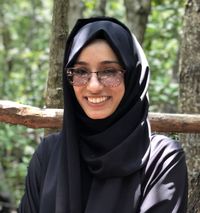

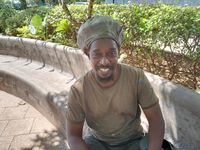
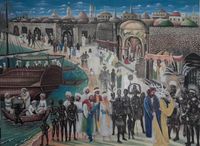
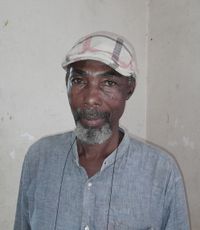
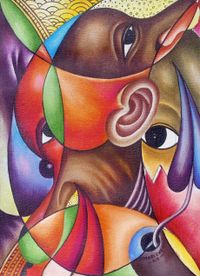
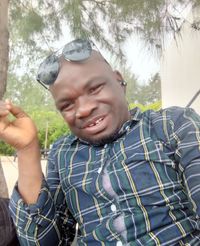
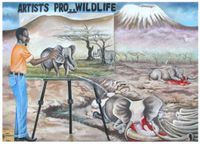


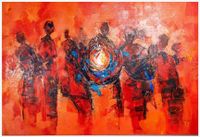
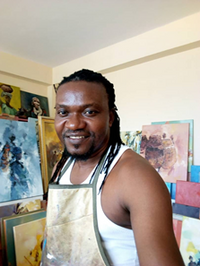


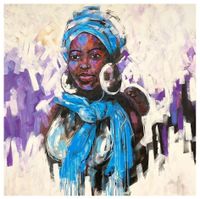

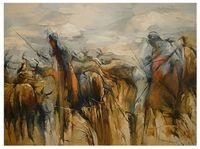

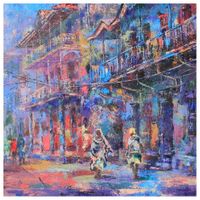
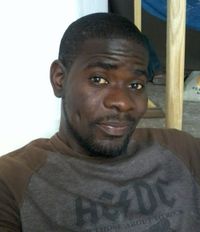



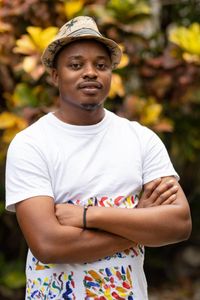
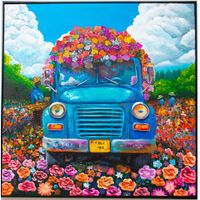
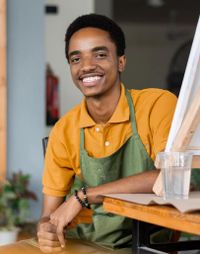

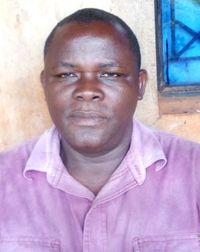
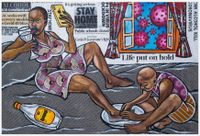


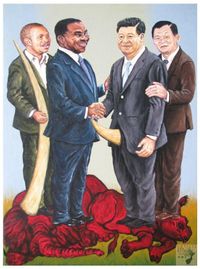
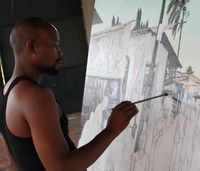
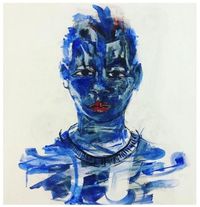
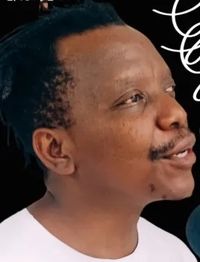

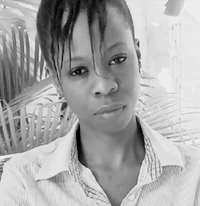
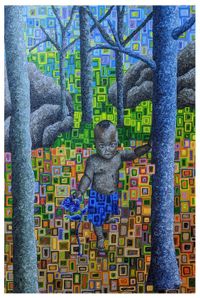

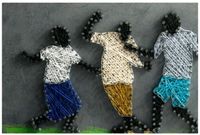
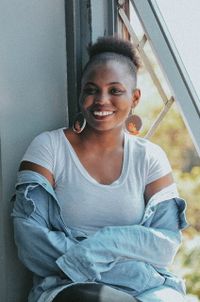

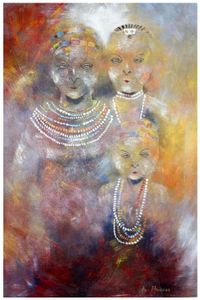

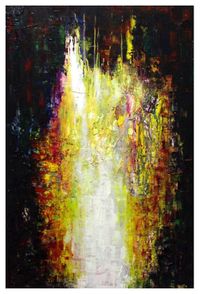
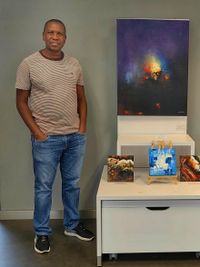

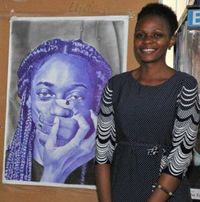
%2C%202023%2C%2059%20x%2050%20cm%2C%20verkauft%20f%C3%BCr%20265%20%E2%82%AC%20bei%20asante.sanaa.de%2C%202023.jpg/picture-200?_=18f8a17d5e8)

